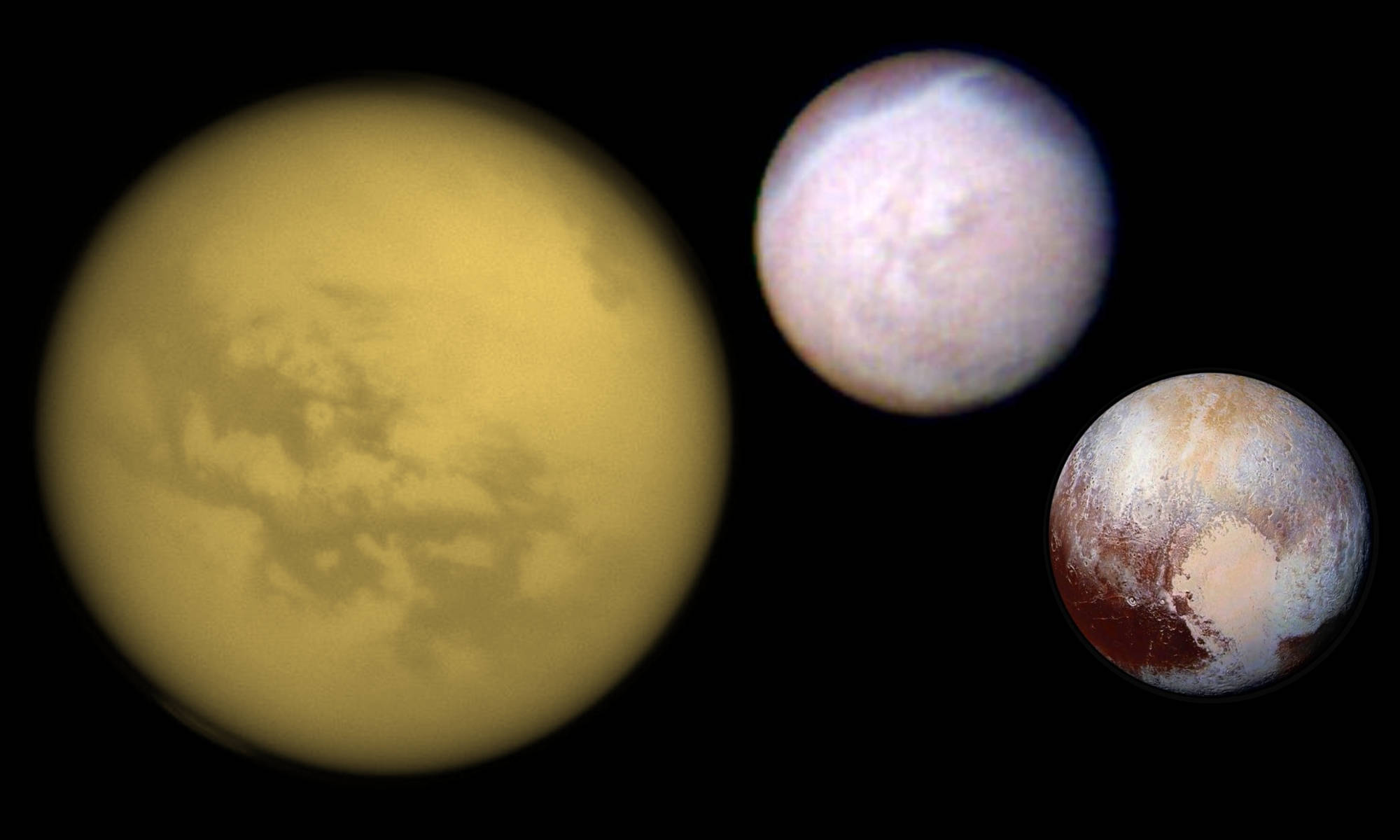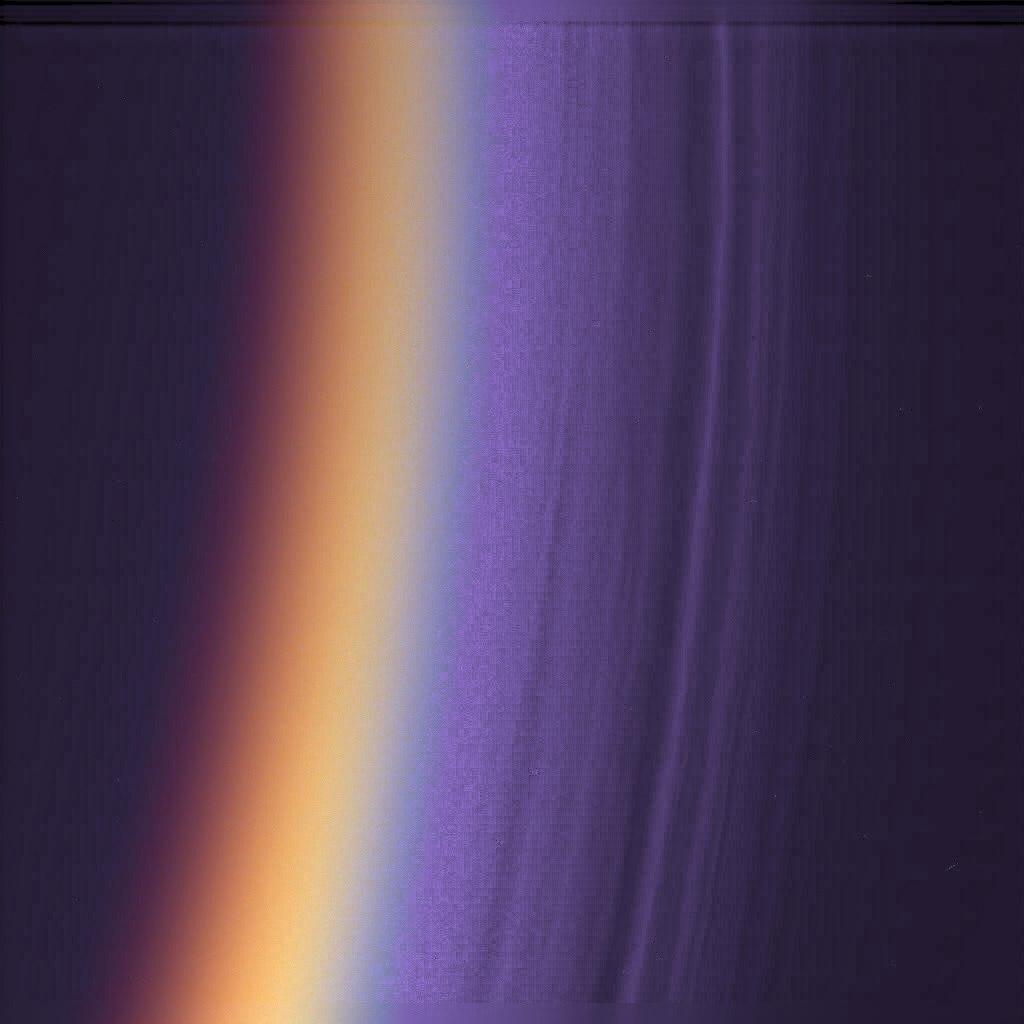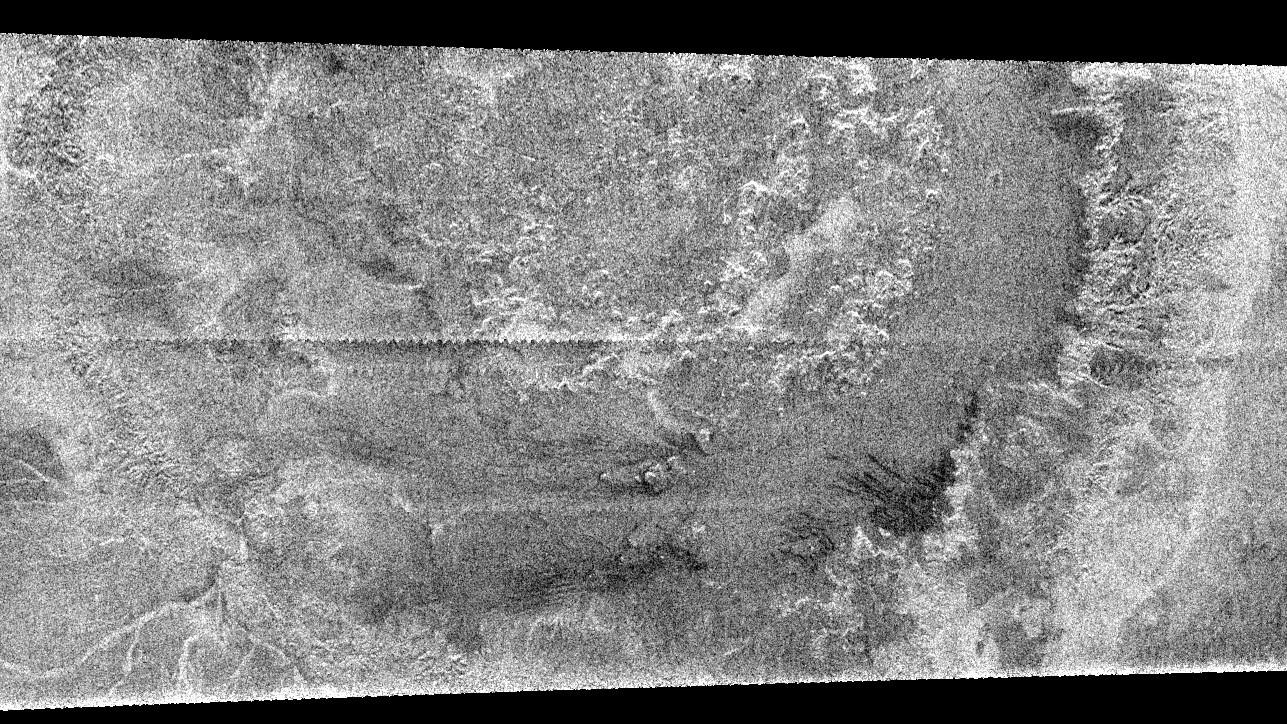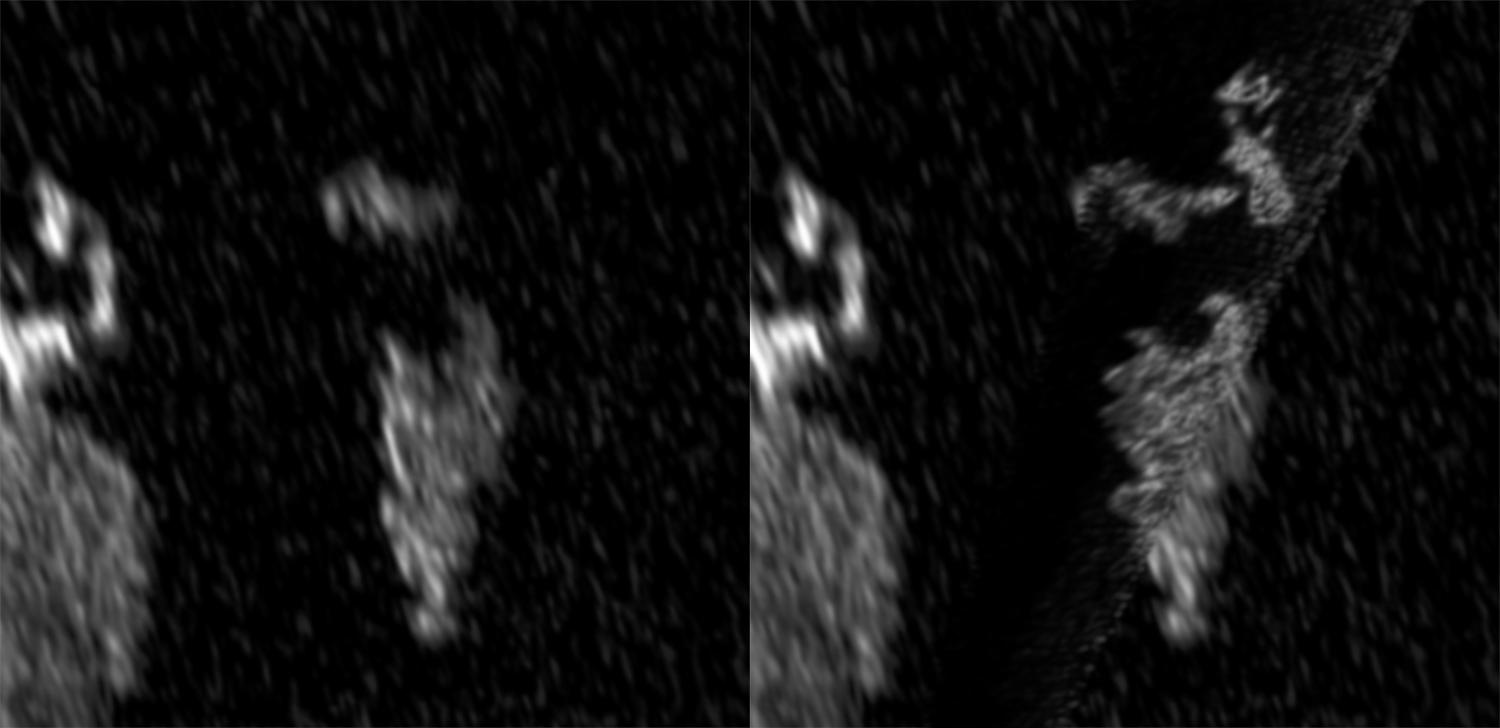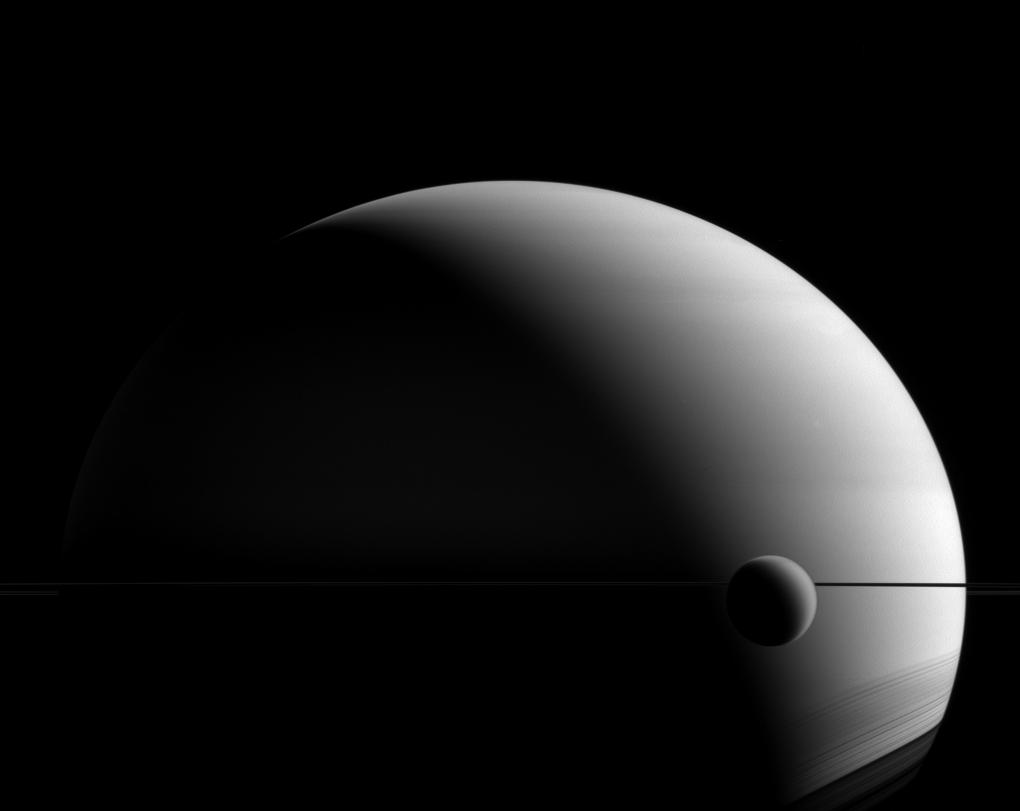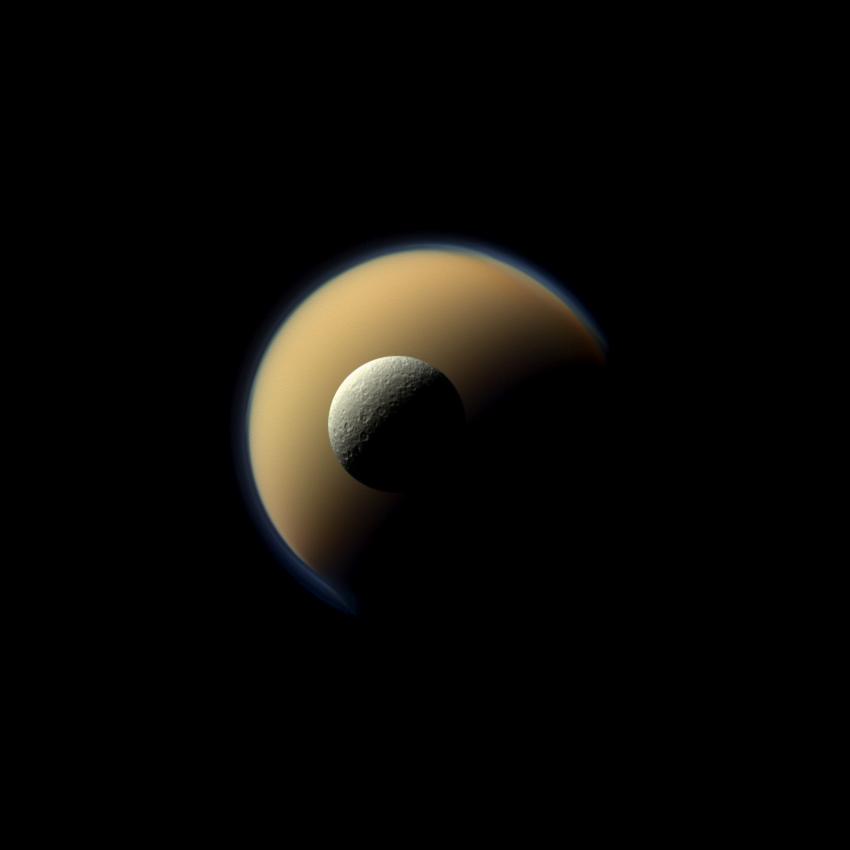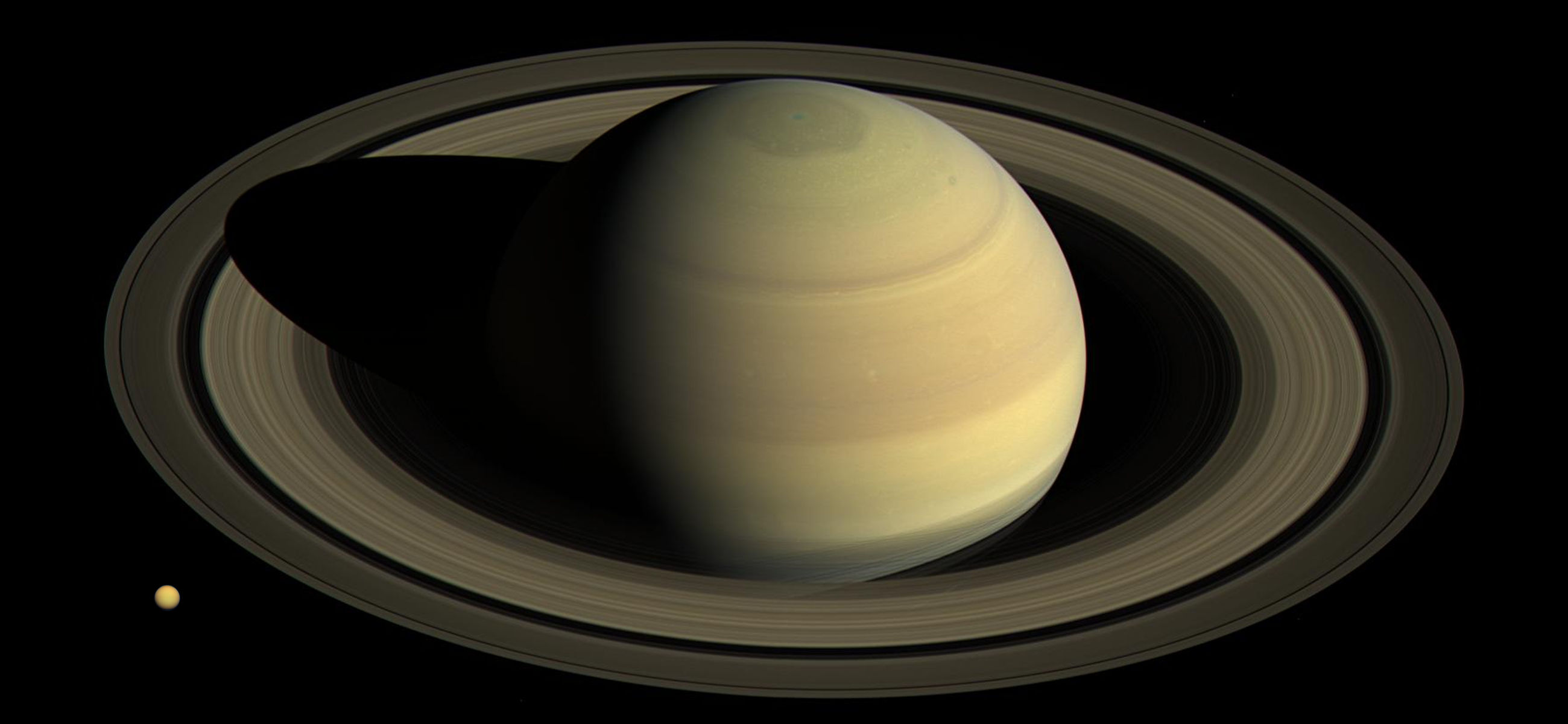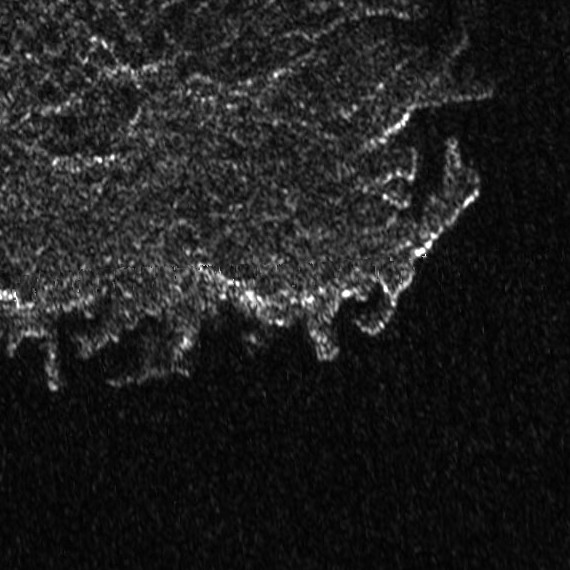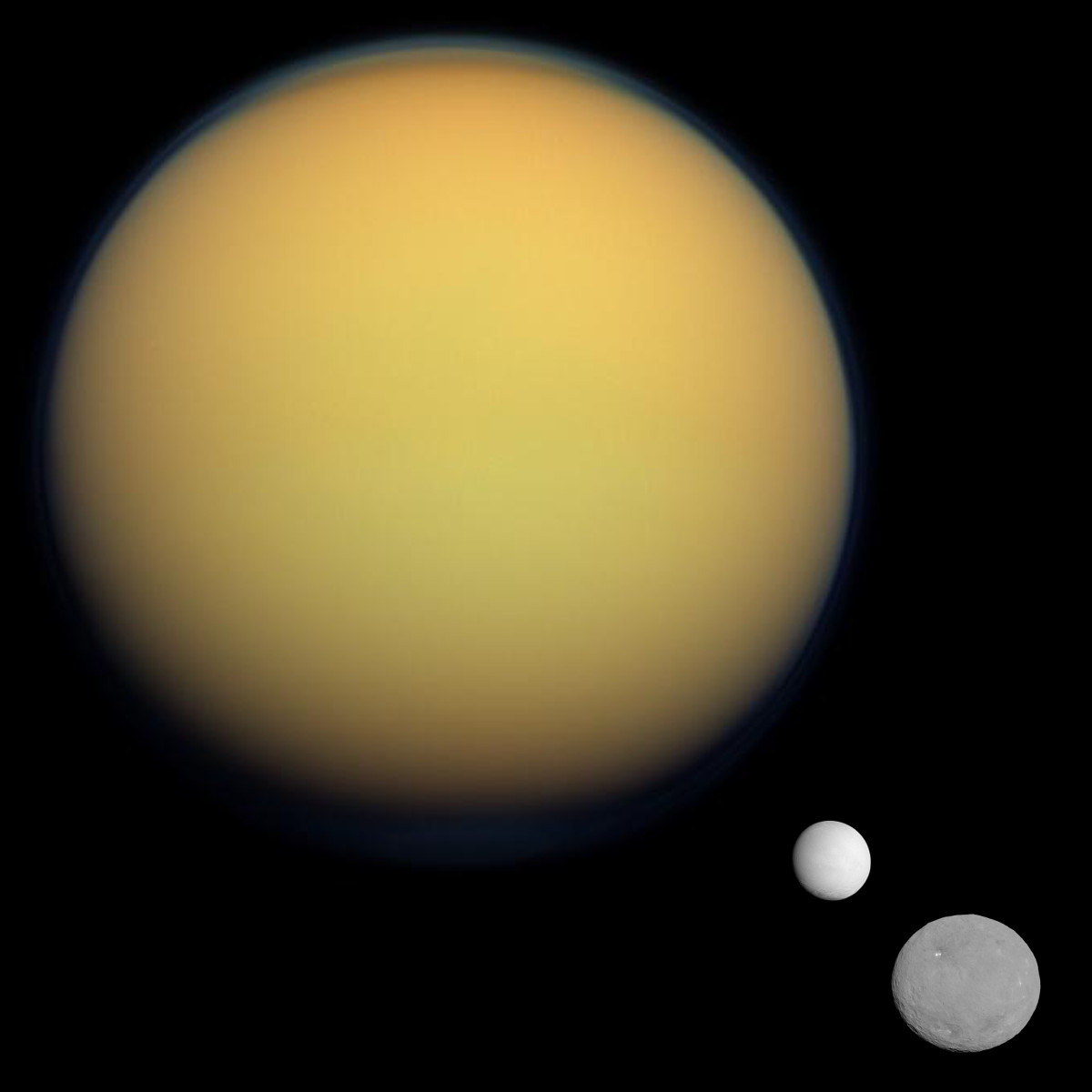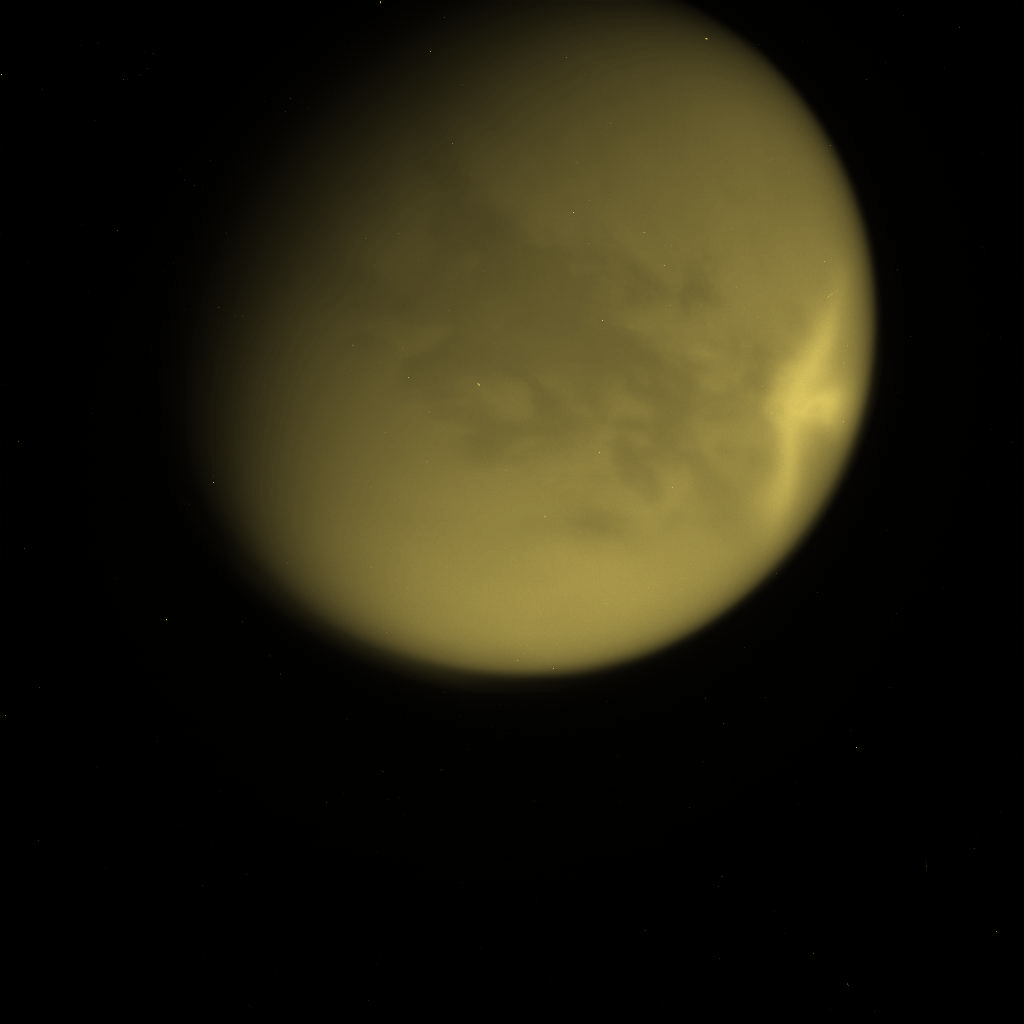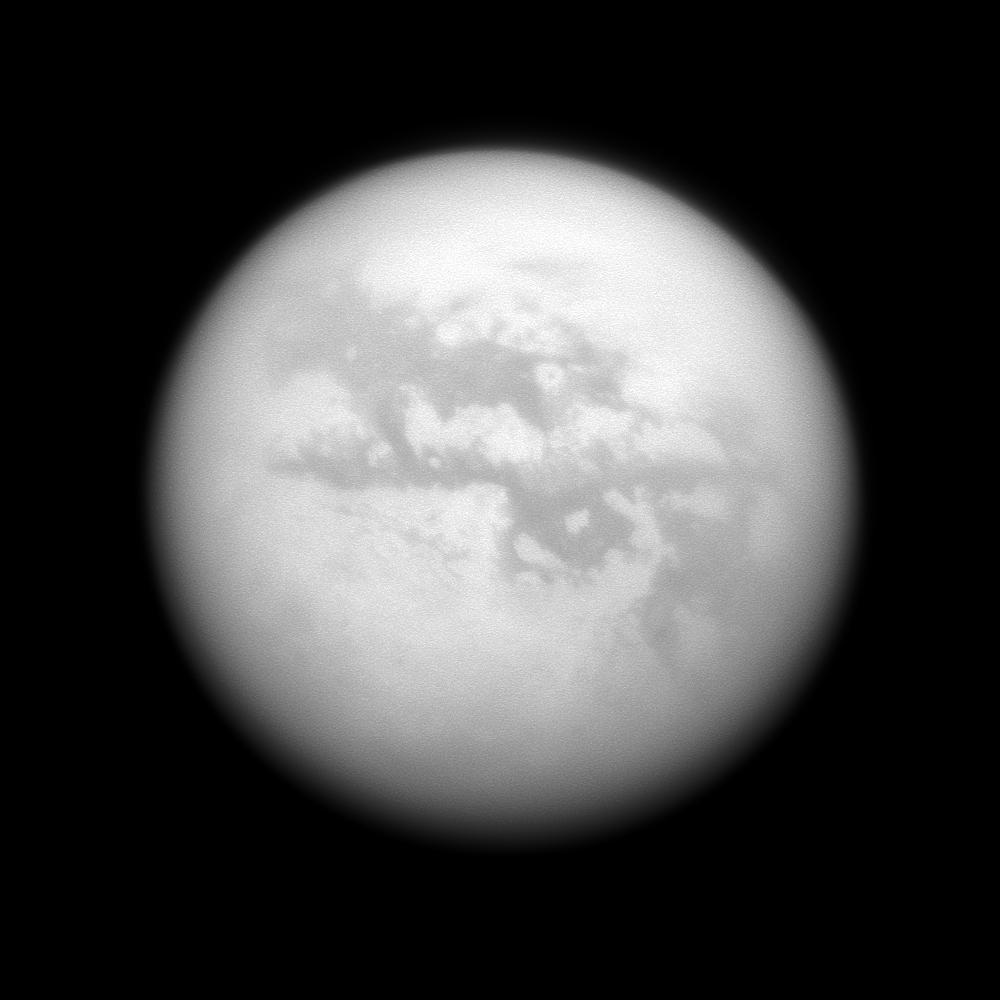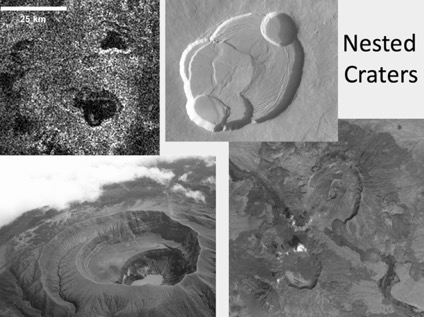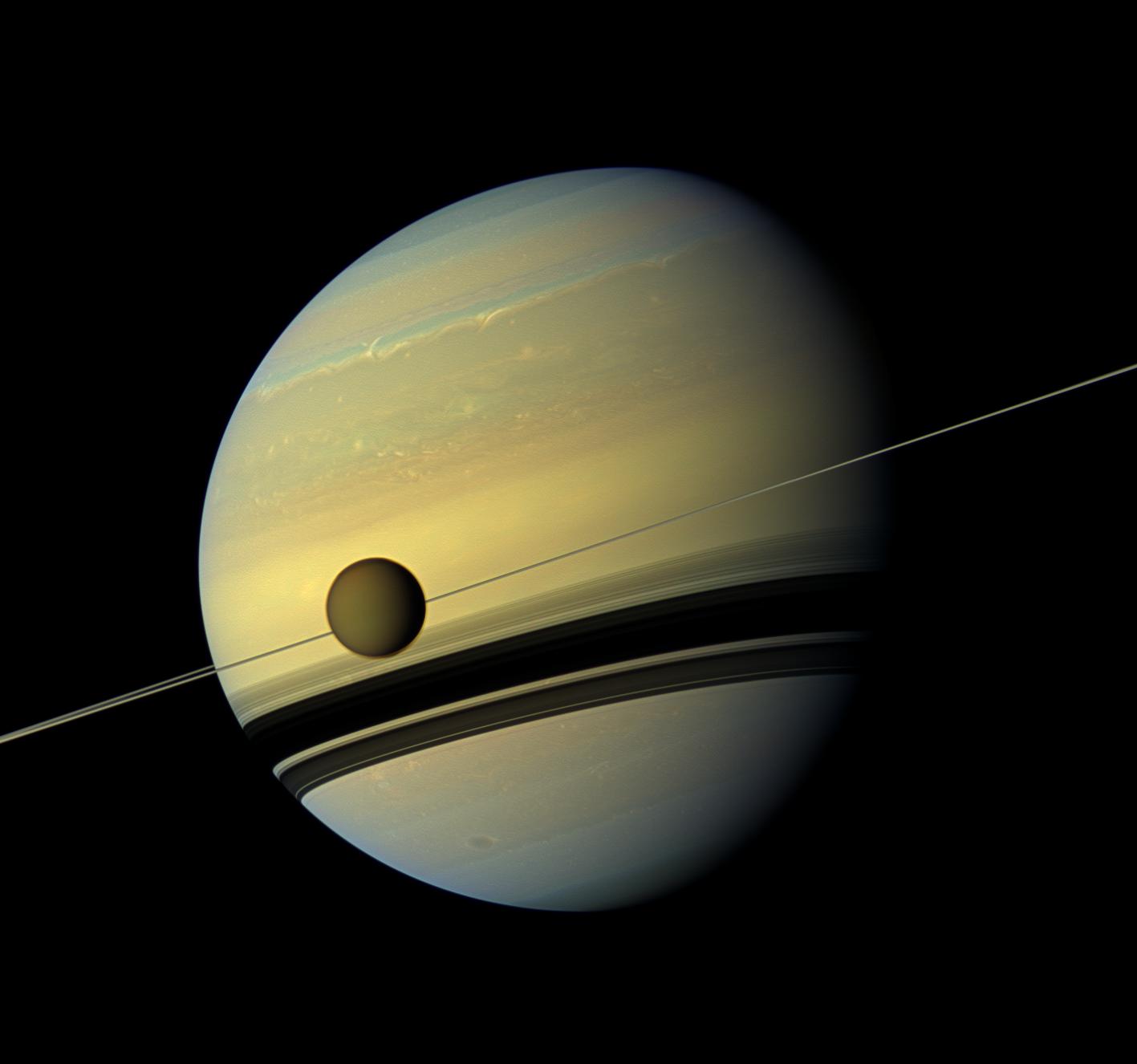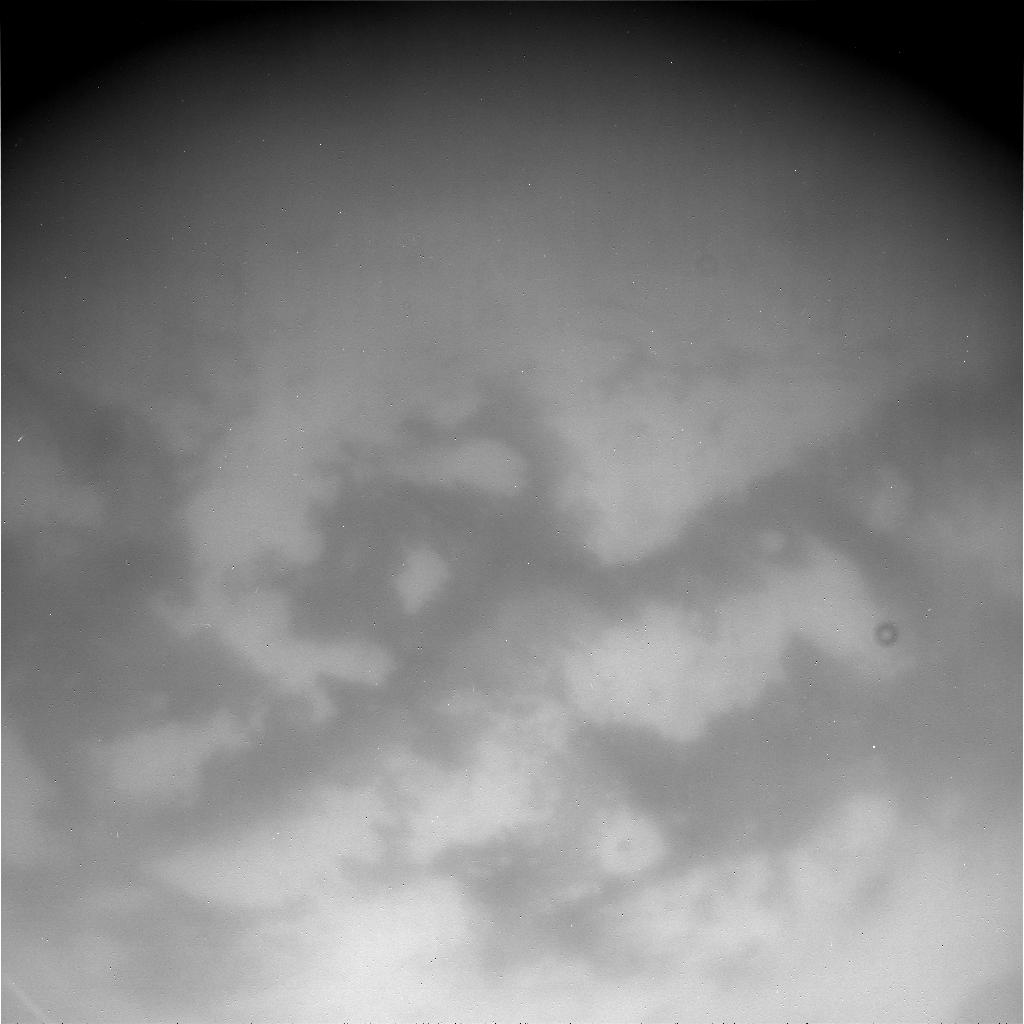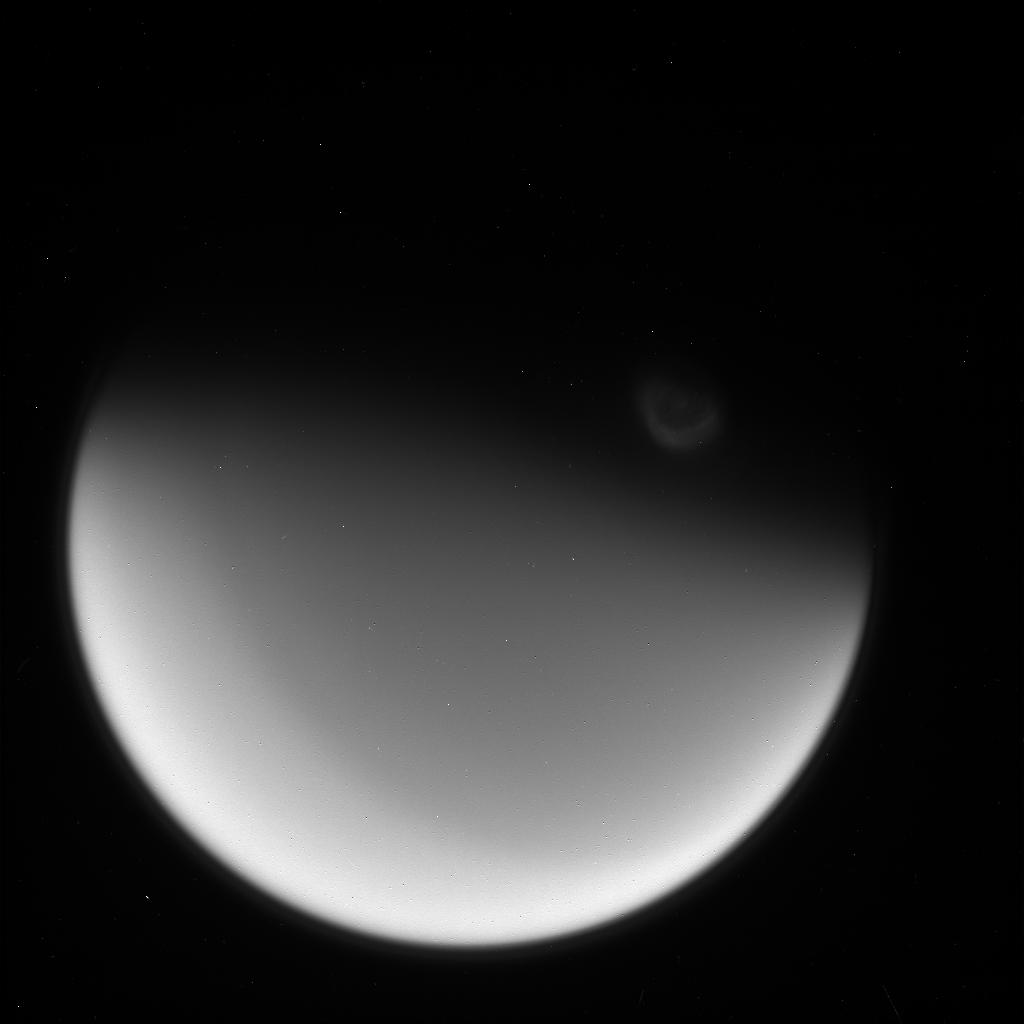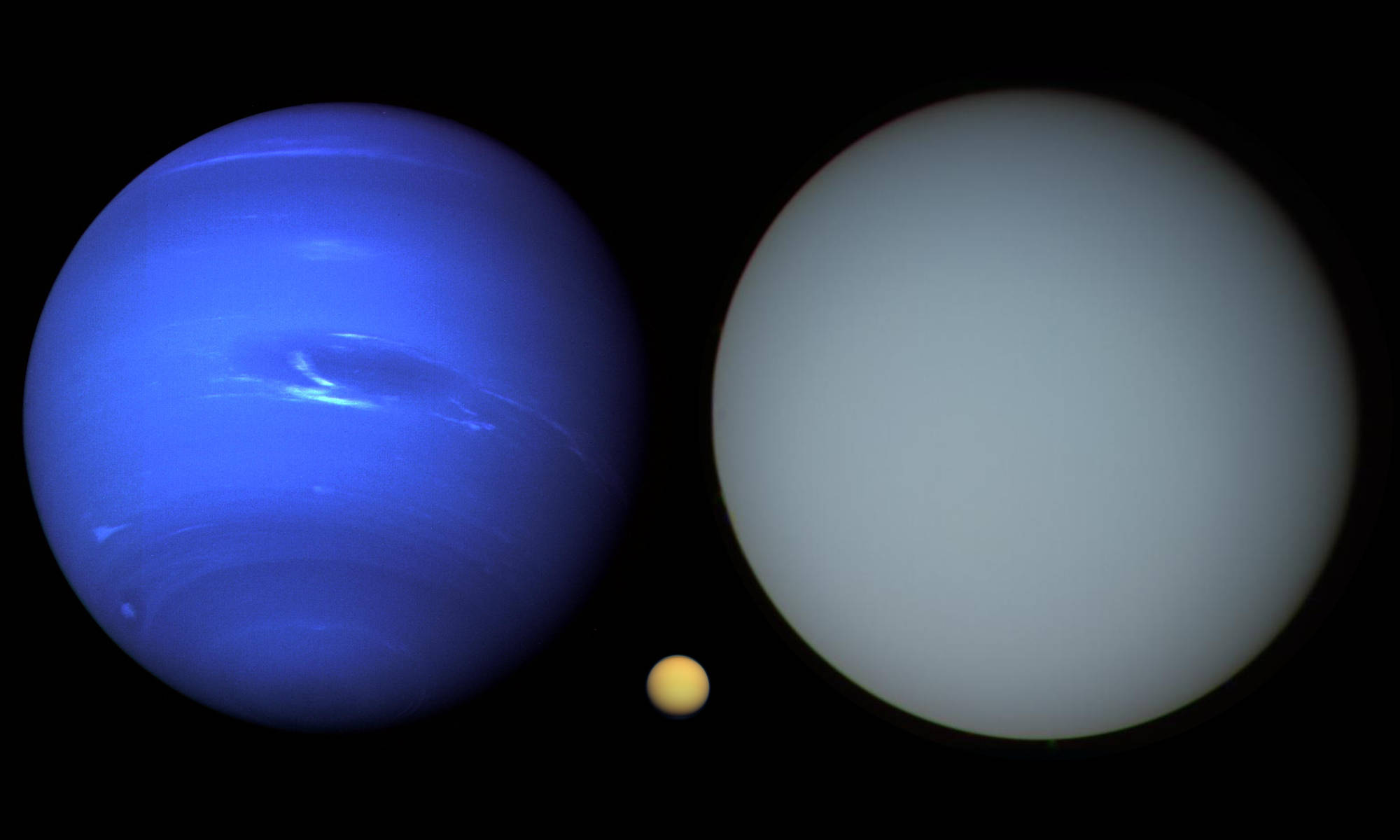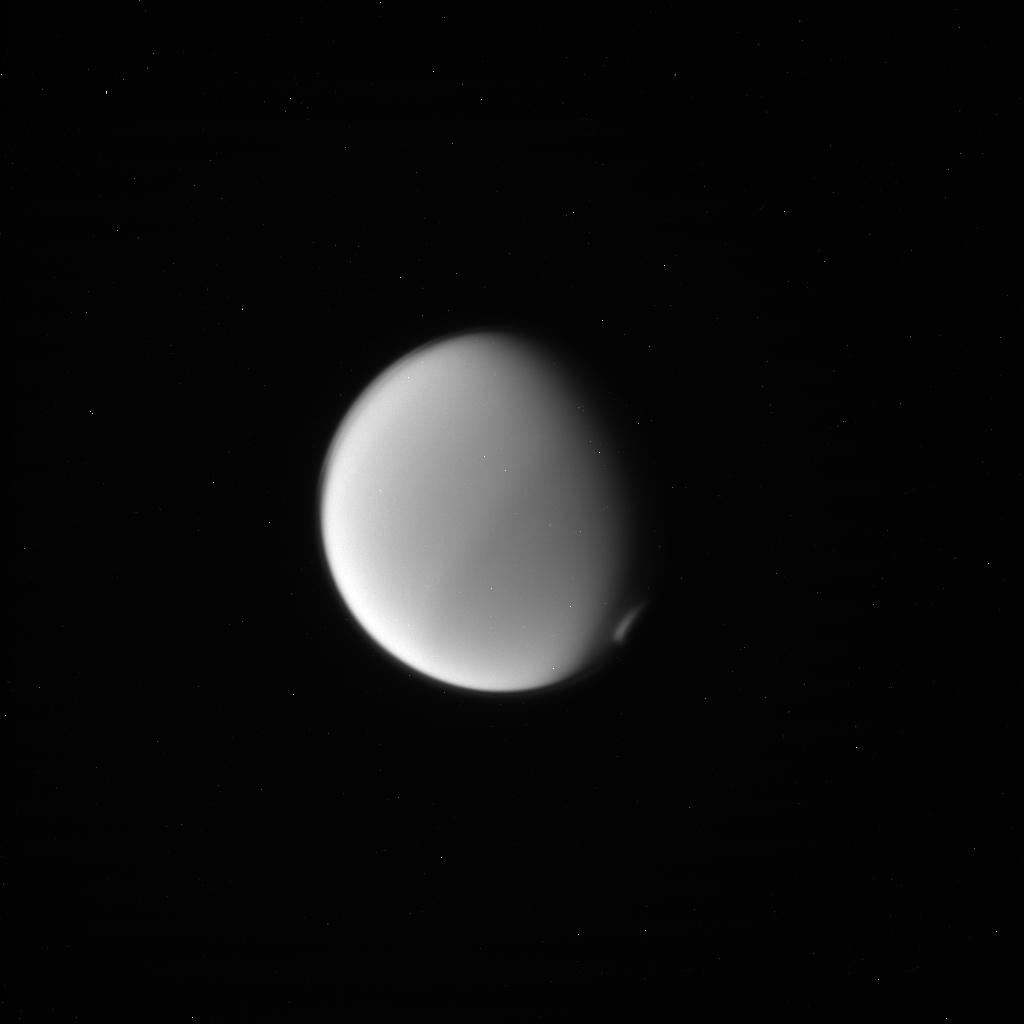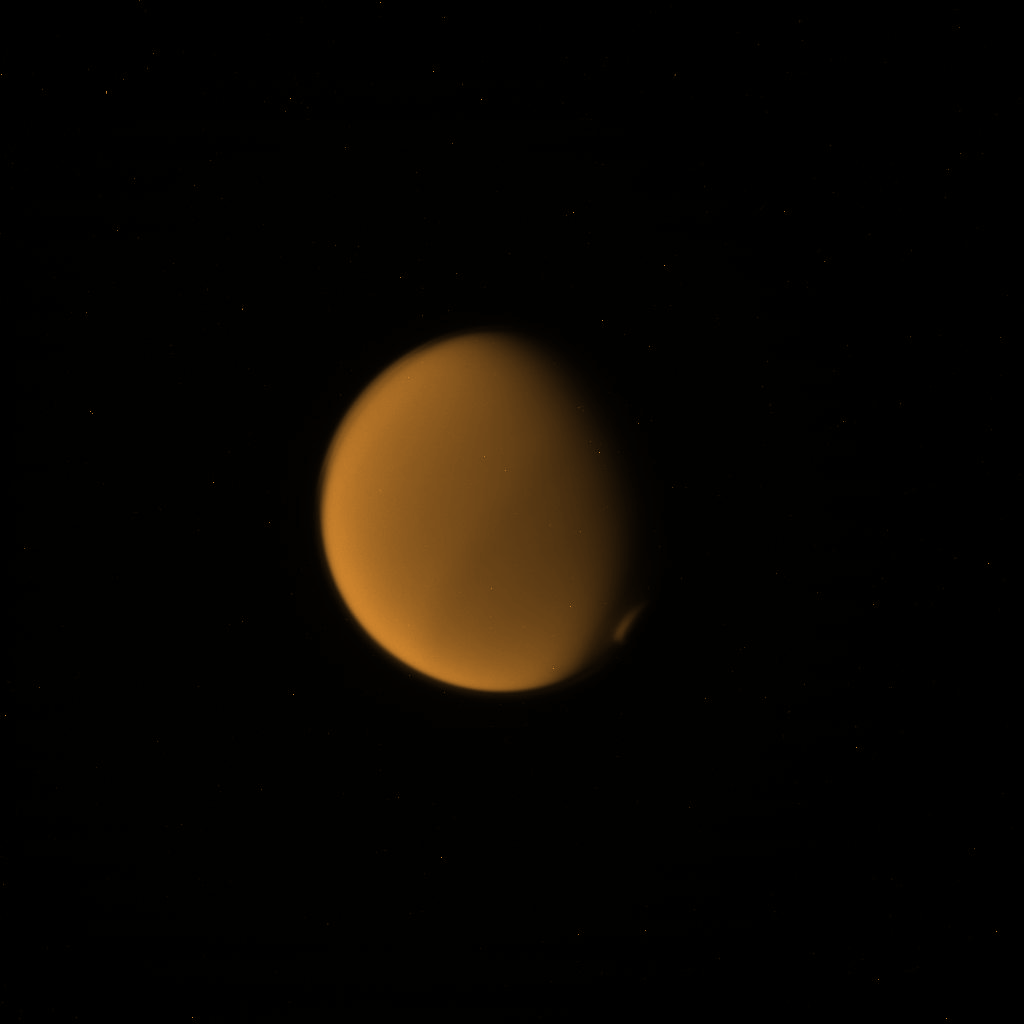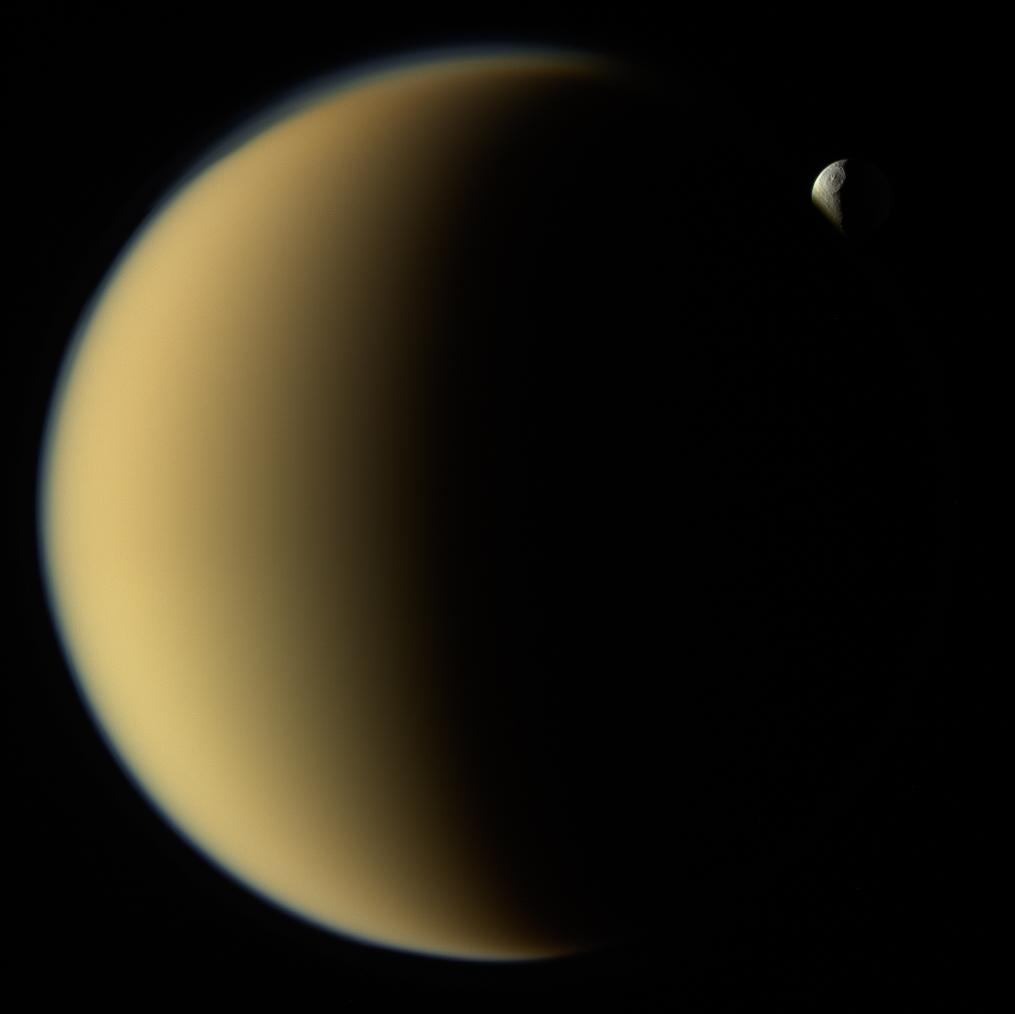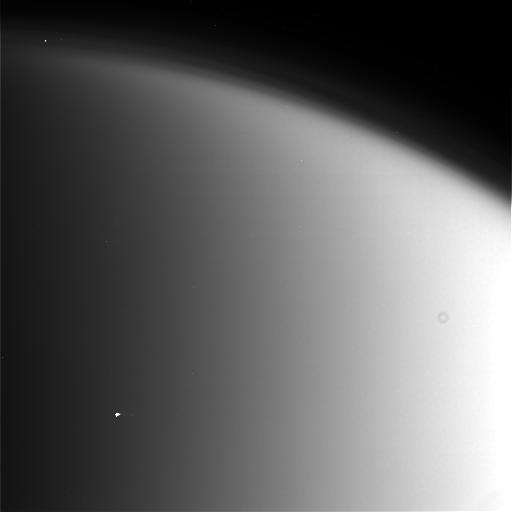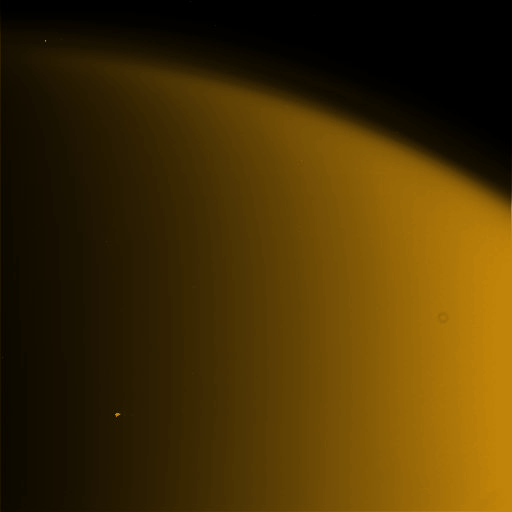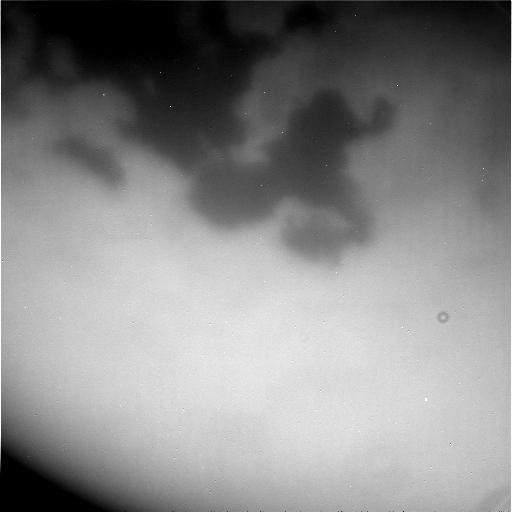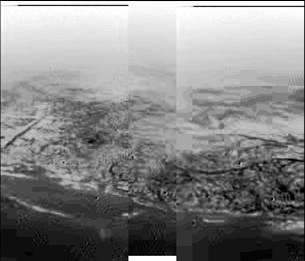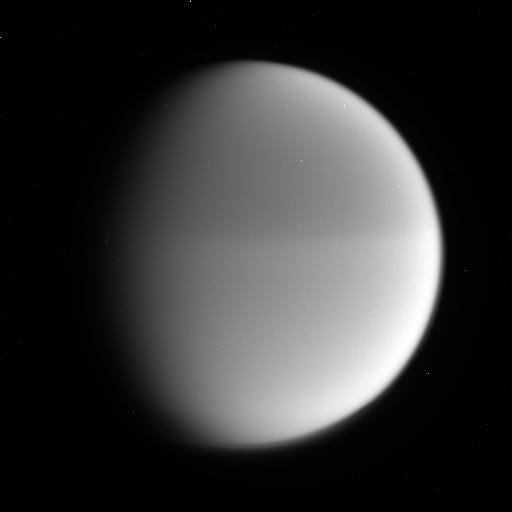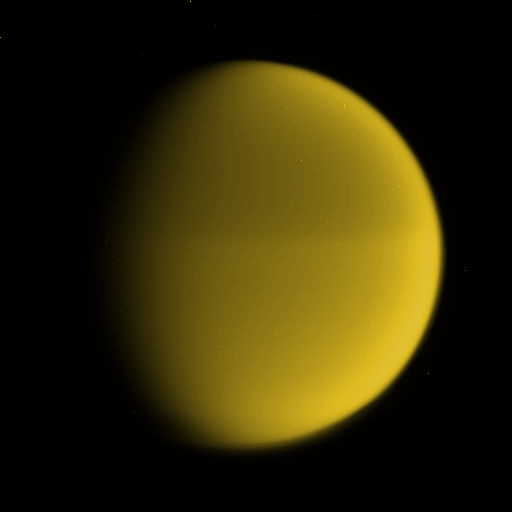Titan News 2020
November 4, 2020 : A New Study Involving Manuel Scherf Unveils The Potential Origin Of The Nitrogen Atmosphere Of Titan, Triton And Pluto
A new study entitled « Nitrogen Atmospheres of the Icy Bodies in the Solar System », involving Manuel Scherf and recently published in Space Science Reviews reveals the potential origin of the nitrogen atmosphere of Titan, Triton and Pluto, three major worlds located in the Outer Solar System. The research work brings key information upon the potential origin and upon the potential evolution of the atmosphere of Titan, Triton and Pluto. The atmosphere of those worlds is known to be dominated by nitrogen. The observations reveal that most moons located in the Outer Solar System are devoid of any significant atmosphere. Titan is really an exception among the numerous moons found beyond Mars due to its remarkable atmosphere. How did the atmosphere of Saturn's largest moon form ? Is the atmosphere of the Orange Moon stable over time ? Is the high atmospheric pressure on Titan's surface related to cryovolcanic events for instance ? How did the atmosphere of Triton and Pluto form ? Is the atmosphere of Triton and Pluto stable over time ? Will it completely disappear in the near future ? Are there cycles in the evolution or in the development of the atmosphere of Titan, Triton or Pluto ?
The atmosphere of Titan looks like the atmosphere of the Earth to a certain extent because the atmosphere of both worlds is dominated by molecular nitrogen. Where do the nitrogen molecules or elements in Earth's atmosphere and in Titan's atmosphere come from ? Researchers can bring major clues regarding the origin or the development of the atmospheres mainly composed of molecular nitrogen by studying, in particular, the 14N/15N ratio in the gas blanket. That ratio can tell us a lot regarding the building blocks of the atmosphere or the building blocks of the surface. The 14N/15N ratio can also tell us a lot regarding the various fractionation processes that engendered or fuelled the atmosphere. In fact, researchers study several isotopic or elemental ratios to better understand the dynamics or the origin of the atmosphere. The astronomers can also analyze the 12C/13C ratio or the Ar/N ratio in the atmosphere in order to deduce the potential history of the atmosphere in particular. Planetologists can mobilize the key data of Titan's atmosphere, Triton's atmosphere or Pluto's atmosphere in order to better understand the potential history of those icy or rocky worlds, to determine the potential mechanisms taking shape in the gas blanket or to determine the potential influence of solar activity upon the chemistry of the atmosphere.
October 27, 2020 : NASA Researchers Identify Cyclopropenylidene In The Atmosphere Of Titan Thanks To The ALMA Observatory
A new research work entitled « Detection of Cyclopropenylidene on Titan with ALMA », involving Conor A. Nixon and published in The Astronomical Journal on October 15, 2020 reveals the identification of cyclopropenylidene in the opaque atmosphere of Saturn's largest moon Titan thanks to data acquired with the ALMA observatory. Cyclopropenylidene whose chemical formula is C3H2 represents a relatively simple hydrocarbon molecule composed of carbon and hydrogen. Cyclopropenylidene appears to be the simplest cyclic hydrocarbon identified in Titan's atmosphere. Benzene, another cyclic hydrocarbon, had already been identified on Titan in 2003. Some researchers advance that cyclopropenylidene may represent a key molecule of organic chemistry, a prebiotic molecule or a molecule involved in the development of a potential ecosystem. The finding was made possible thanks to the Atacama Large Millimeter/submillimeter Array (ALMA), a radio telescope observatory located in northern Chile. The planetologists analyzed the spectrum of unique light signatures obtained by the ALMA observatory in order to determine the chemical composition of the hazy atmosphere of the enigmatic moon. The way the molecules emit or absorb solar energy allows astronomers to infer the chemical composition of the atmosphere studied.
Conor Nixon who is a planetary scientist at NASA's Goddard Space Flight Center in Greenbelt, Maryland and who led the research work pointed out : « When I realized I was looking at cyclopropenylidene, my first thought was, 'Well, this is really unexpected' ». C3H2 appears to be a relatively simple molecule which has already been found in the clouds of gas and dust located in interstellar space. C3H2 can in fact form in particularly cold environments where chemical reactions are limited and where the relatively low density makes chemical reactions less frequent. Planetologists had never found that molecule in any atmosphere prior to the new finding. That's why researchers were really surprised to detect or identify that molecule in the atmosphere of that giant moon of Saturn. Titan's atmosphere is particularly dense and complex due to its haze of organics or hydrocarbons engendering numerous chemical reactions. Complex chemical reactions take shape or develop in the upper atmosphere of the Opaque Moon under the influence of ultraviolet light from the Sun in particular. Planetologists or exobiologists are particularly interested in the study of the soup of chemicals encountered in that region of Titan's atmosphere.
October 6, 2020 : A New Study Of Impact Craters On Titan Reveals The Potential Presence Of Different Materials Like Tholin Or Water Ice
A new study entitled « The chemical composition of impact craters on Titan », published by Astronomy & Astrophysics and involving Catherine Neish reveals that the impact craters of Saturn's largest moon unveil different compounds and bring clues regarding the composition of the crust. The group of researchers resorted to data obtained from the Visual and Infrared Mapping Spectrometer of the Cassini spacecraft to analyze the potential composition of several impact craters. The impact craters found in the equatorial areas where dune fields are widespread tend to be rich in tholin or dark material whereas the impact craters found at higher latitudes reveal what may be water ice as well as other compounds like tholin, hydrocarbons or organics. Some researchers advance that the recent or fresh impact craters can reveal some compounds related to an ancient ecosystem. The Titanian impact craters can unveil major clues regarding the nature of the crust or the nature of the sediments. Due to the thick atmosphere of the giant moon, most meteorites don't reach the surface because they disintegrate in the air and any impact crater tends to undergo a relatively strong erosion over time like on Earth.
Planetologists have used the infrared and near-infrared data obtained with the VIMS in particular to study surface features on Titan because the atmosphere is completely opaque from outer space in the visible spectrum. The low or mid-latitudes of the Hazy Moon appear relatively dry and unveil vast areas composed of linear and parallel dunes extending over long distances. In the low-albedo areas of the low or mid-latitudes where sand is widespread, any impact crater will likely be rapidly buried with the sand driven by prevailing winds. Therefore, any impact crater can appear relatively uniform. At higher latitudes, the logic is different because the environment tends to be wetter or less dry so that any meteorite or comet will not engender the same type of impact crater. Some craters unveil bright materials which may correspond to the signature of water ice. The crust of Titan is probably rich in water ice like the crust of the other major moons of Saturn. If the crust of Saturn's largest moon is unstable with fractures or cryovolcanoes for instance, one can imagine that any material or compound of the presumed subsurface ocean can go up toward the surface. That's why impact craters are potentially interesting exobiologically speaking.
October 5, 2020 : A Layer Relatively Rich In Ethane And Relatively Poor In Nitrogen Above A Layer Relatively Rich In Methane And Nitrogen In The Shallow Pools Of Titan ?
A new study entitled « Stratification Dynamics of Titan's Lakes via Methane Evaporation », recently published in The Planetary Science Journal and proposed by a team led by Jordan K. Steckloff who is a researcher at the Planetary Science Institute, suggests that the shallow pools of liquids on Titan may paradoxically contain a layer dominated by ethane above a layer dominated by methane. That stratification phenomenon may be related to a difference in the density of the layers. The layer whose density is higher will be found beneath the layer whose density is lower. The stratification phenomenon can also be encountered on Earth where temperature variations play a key role in the formation of the layers. Planetologists believe that the lakes or seas of Titan are dominated by a mixture of methane, ethane and dissolved nitrogen. The concentration of those compounds in the lakes or seas can vary depending on the area, on the season or on the depth. The nitrogen molecules or elements present in Titan's atmosphere can interact with the lakes or seas and engender stratification phenomena. If the layer dominated by methane is enriched in nitrogen, the density of that layer can become higher than that of the layer dominated by ethane so that the layer dominated by methane evolves beneath the layer dominated by ethane.
Methane, ethane or even propane can appear in their liquid form on the surface of Saturn's largest moon due to the extremely low environmental temperature encountered at the level of the surface. Methane whose chemical formula is CH4 is lighter than ethane whose chemical formula is C2H6. So, we could imagine a layer of pure methane above a layer of pure ethane. But reality may be much more complicated on the Opaque Moon due to the complex interactions between the hydrocarbons of Titan and, in particular, between compounds like methane, ethane and nitrogen. On Earth, during the Summer season, the higher environmental temperature engenders an expansion of the hot water so that its density decreases and becomes significantly lower than the density of the cold water. In that configuration, a stratification phenomenon between the hot water and the cold water takes shape. The hot water whose density is lower will form a layer that will float above a layer of cold water. The typical stratification phenomenon on our planet is related to temperature variations in the environment. On Titan, the stratification phenomenon is rather intimately linked to chemical interactions between various compounds.
October 2, 2020 : A Subsurface Ocean Of Salty Water Relatively Rich In Complex Organics Beneath The External Crust Of Titan ?
The system of Saturn reveals several moons that may contain a subsurface ocean dominated by liquid water. The Ringed Planet gravitationally interacts with its numerous moons and potentially engenders a relatively strong internal activity for Enceladus, Tethys, Dione, Rhea or even Titan. The moons of the Saturn System undergo the gravitational influence of the Gas Giant as well as the gravitational influence of the other moons in orbit around Saturn. Tidal forces are known to play a key role in the remarkable volcanism of Io, one of the major moons of Jupiter, for instance. Enceladus, the bright icy moon of Saturn, unveils geysers in the fractures found in its south polar region. Those regular eruptions or cryovolcanic events may be closely related to the tidal forces generated by Saturn and the other moons. The geysers of the tiny moon imply that there may be a layer or pockets dominated by liquid water beneath the external crust. Most researchers did not expect to observe such a level of internal activity for a tiny moon whose diameter is around 500 km. The geysers of Enceladus were identified during the Cassini-Huygens mission thanks to the Cassini orbiter which had captured many images of the bright moon from 2004 to 2017.
Planetologists have noted that the moons of Saturn are generally remarkably rich in water ice. The surface of the icy moons tends to be heavily cratered. However, the external crust of moons like Enceladus, Tethys, Dione or Rhea may evolve above a layer dominated by liquid water. The study of Saturn and its moons has clearly changed our view of the worlds found in the Outer Solar System. The moons found beyond Mars receive less energy from the Sun than worlds like Venus or the Earth but they can be active in their interior thanks to the tidal forces generated by the Gas Giants or the Dwarf Planets. That's obviously the case for Io and that may also be the case for moons like Europa, Ganymede, Miranda or Triton. The giant moon Titan evolves farther from Saturn than Mimas or Enceladus but researchers believe, on the basis of data acquired from the Cassini spacecraft, that Titan contains a subsurface ocean dominated by salty liquid water. The presumed subsurface ocean may be found at a depth of at least 50 km or 30 miles beneath the ground. The exact nature of the liquid is unknown due to the limited amount of clues. The exact depth of the hypothetical subsurface ocean is also unknown.
September 24, 2020 : A New Study Proposed By Samuel W. Bell Suggests A New Chronology Based On Planetocentric Impactors For Titan And The Other Moons Of Saturn
A new research work proposed by Samuel W. Bell, published in the Journal of Geophysical Research Planets and entitled « Relative Crater Scaling Between the Major Moons of Saturn: Implications for Planetocentric Cratering and the Surface Age of Titan », suggests a new chronology for Titan and the other moons of the Gas Giant Saturn. Titan is the only moon of Saturn containing a significant atmosphere and that atmosphere engenders relatively strong erosional processes. Therefore, the age of Titan is hard to determine since researchers can't base their analyses on the concentration of impact craters on Saturn's largest moon because Titanian craters tend to disappear over time due to erosional processes. However, the study of craters on the other major moons of the Ringed Planet can allow us to infer the potential age of the Opaque Moon. The difficulty is to determine the fraction of impactors which represent planetocentric impactors and the fraction of impactors which represent heliocentric impactors. The moons of Saturn may turn out to be much younger than previously believed if most of the impact craters are related to planetocentric impactors.
Samuel W. Bell who is an Associate Research Scientist at the Planetary Science Institute and who was working at Brown University's Center for Computation and Visualization and the Planetary Science Institute at the time of his study upon the chronology of Saturn moons pointed out : « Most studies dating surfaces on the Moon or Mars rely on counting how many impact craters have formed and knowing the cratering rate, but on the moons of Saturn, we do not know the cratering rate. » Previous assessments upon the chronology or the age of the Saturn moons have been based on the assumption that most impacts or craters come from heliocentric impactors or objects orbiting our star. The author added : « If the impacts came solely from Sun-orbiting objects, the relative cratering rate would be much, much higher the closer the moons are to Saturn. However, the crater densities of the oldest surfaces of Mimas, Tethys, Dione, Rhea, and Iapetus are all relatively similar. » A giant world like Saturn is likely to act as a vacuum cleaner for any asteroid or comet entering the area of the Gas Giant due to its relatively high gravity. That's why one can assume that the nearest moons to Saturn may be more heavily cratered than the other moons of the Ringed Planet if most impacts are related to heliocentric impactors rather than planetocentric impactors.
September 14, 2020 : The Atmosphere Of Titan And The Atmosphere Of Saturn Represent Key Atmospheres To Study In Our Solar System
Most worlds in the Solar System are devoid of any atmosphere because they don't have the right combination of gravity and environmental temperature. A world like Mercury is not heavy enough at its distance from the Sun to retain a significant atmosphere for instance. At the level of Mercury, the level of solar energy received by Mercury's surface appears too high for the presence of a stable atmosphere. Venus, the Earth and Mars which evolve farther from the Sun and which are bigger than Mercury contain an atmosphere whose weight is very different. Beyond the Asteroid Belt, there are the four Gas Giants which are dominated by an extremely deep and thick atmosphere. Those worlds which evolve in a particularly harsh environment are heavy enough to retain a significant atmosphere. Jupiter, the largest planet in the Solar System, is well known for its numerous hurricanes or vortices. Saturn is well known for its rings and for its hexagonal structure in the north polar region. Uranus is considered an Ice Giant because it is an extremely cold world that tends to appear featureless in the visible spectrum. Neptune represents another Ice Giant and another blue planet where giant clouds can be found and where winds blow at an extremely high speed.
In the Outer Solar System, beyond the Asteroid Belt, several rocky or icy worlds contain an atmosphere. That's the case for Titan, the largest moon of Saturn. The surface of Titan has long represented a mystery because the atmosphere is completely opaque from outer space in the visible spectrum. The Voyager 1 spacecraft and the Voyager 2 spacecraft had captured images of the hazy world but we had not been in a position to discern surface features. The Cassini-Huygens mission has clearly revolutionized our level of understanding of the Opaque Moon. Triton, the largest moon of Neptune, also contains an atmosphere but that gas layer is very thin compared to the atmosphere of the Earth or Mars. To a certain extent, the atmosphere of Triton can be compared to the atmosphere of the Dwarf Planet Pluto which unveils several atmospheric layers. The atmosphere can have a strong impact on the landscape due to erosional processes related to winds, snowfall or rainfall events. Dunes can take shape for instance. That's the case on Venus, on Earth, on Mars, on Titan or on Pluto. Clouds imply precipitation phenomena that can fuel rivers, lakes or seas. That's the case on Earth and on Titan.
August 27, 2020 : An Ecosystem In Kraken Mare Or Ligeia Mare Explored By A Submarine In The Coming Decades ?
Beyond Earth, in the Solar System, there is another world where pools of stable liquid can be found on the surface. That world is Titan, the largest moon of the Gas Giant Saturn. The radar views as well as the infrared or near-infrared views of the second largest moon in the Solar System have clearly shown that the polar regions of that enigmatic world contain lakes, seas and rivers. Curiously, the pools of liquid are mostly concentrated in the high latitudes. The most humid area of Titan appears in the high latitudes of the northern hemisphere. The south polar region is dominated by Ontario Lacus, a lake or sea whose shape is reminiscent of a foot. The north polar region is dominated by Kraken Mare, Ligeia Mare and Punga Mare. Those lakes or seas represent key targets to explore in the coming decades. Specialists of Titan are eager to explore those attractive areas via probes, boats, drones or submarines. The exact nature of the liquid found in the pools or rivers of Titan remains a mystery today. However, the key molecules of the lakes, seas and rivers of the Opaque Moon must be methane and ethane. The concentration of each molecule within the liquids may be intimately linked to the period of the Titan year or may be intimately linked to the area of the globe.
A presentation upon the concept of a submarine to explore the lakes or seas of Titan was recently performed by Steven Oleson of NASA's Glenn Research Center in Ohio with the Future In-Space Operations working group from the agency. Steven Oleson pointed out that a submarine to explore the seas or lakes of Titan may represent the first step in the exploration of extraterrestrial lakes, seas or oceans. If the mission which involves a submarine to explore the lakes or seas of the Orange Moon is a success, we will be in a position to develop more complex missions to explore the subsurface lakes, seas or oceans of worlds like Europa or Enceladus. Europa and Enceladus contain an icy crust which represents a barrier for the study or the exploration of the presumed subsurface ocean of liquid water hidden beneath that icy crust which may be relatively thick. Several other worlds in the Solar System may also contain subsurface lakes, seas or oceans of liquid water. One can mention Ceres, Ganymede, the largest moon in the Solar System, Triton or Pluto. Titan may also contain a subsurface ocean of liquid water but the lakes, seas or rivers found on the external crust are likely dominated by a mixture of methane and ethane.
August 18, 2020 : The Opaque Moon Titan Or The Dwarf Planet Ceres Are Part Of The List Of Potential Ocean Worlds
At first sight, the Earth appears exceptional in the Solar System because its surface is dominated by liquid water. No other world in the Solar System contains any ocean of liquid water on its surface. Most moons in the Solar System are devoid of any atmosphere. Therefore, they can't contain any stable pool of liquid compounds on their surface. On our planet, there are the right combinations of atmospheric pressure and environmental temperature for the presence of stable pools of liquid water and we live in an environment where liquid water is widespread. The oceans represent, approximately, 70 percent of the surface of the Earth. Mercury, the nearest planet to the Sun, is devoid of any atmosphere. That's why its surface is heavily cratered and devoid of any lake, sea or river. Venus looks like the Earth and may have contained seas or oceans of liquid water in the past but today, the surface of Venus is a hell where water can't appear in its liquid form. The environmental temperature is so high on the surface of Venus that lead could be encountered in its liquid form on the surface. The only extraterrestrial world where stable pools of liquid can be found on the surface is the giant moon Titan.
The moons Titan and Io clearly demonstrate the potential diversity of worlds beyond the Solar System. Io is a major moon of Jupiter where the tidal forces exerted by the Gas Giant and the other moons of that planet engender an extremely strong volcanic activity. The volcanic eruptions on Io can reach high altitudes which can represent several hundred kilometers. Giant lakes of volcanic lava can regularly form. In fact, Io is the most active world in the Solar System. Titan has also pools of liquids but the lakes, seas or rivers found on the Opaque Moon are related to a meteorological cycle. To a certain extent, Titan looks like the Earth. Titan's atmosphere is dominated by molecular nitrogen like our atmosphere. The main difference in terms of atmospheric composition is that the second most abundant gas in Titan's atmosphere is methane whereas the second most abundant gas in our atmosphere is oxygen. On Titan, there is a meteorological cycle involving methane whereas on our planet, there is a meteorological cycle involving water. There can't be stable pools of liquid water on Titan's surface but water is widespread in the System of Saturn and subsurface oceans of liquid water may in fact exist beneath the external crust of Titan or Enceladus.
July 11, 2020 : What Types Of Exotic Phenomena Might We See On The Surface Of Titan ?
On Earth, one can observe, from time to time, remarkable phenomena such as lightning, magnetic auroras, rainbows, tornadoes or twisters. Could those phenomena be observed on Saturn's largest moon Titan ? Planetologists often say that Titan and the Earth look alike to a certain extent. Titan is covered in a relatively thick atmosphere like our planet. Most moons in the Solar System are devoid of any atmosphere and Titan represents an exception. Titan is much lighter than the Earth but it contains a deeper, thicker or denser atmosphere than the Blue Planet. The study of Titan's atmosphere can tell us a lot regarding the dynamics or the evolution of our atmosphere. The chemistry of Titan's atmosphere draws the whole attention of planetologists or exobiologists. Titan's atmosphere is dominated by molecular nitrogen like our atmosphere. However, oxygen is absent or almost absent in the atmosphere of Saturn's largest moon. Methane appears to be the second most abundant compound in that exotic atmosphere. There is a methane cycle between the atmosphere, the surface and probably the interior of the giant moon. In fact, typical phenomena regularly encountered in Earth's atmosphere can be observed in Titan's atmosphere.
Thanks to the Cassini-Huygens mission, we have been in a position to collect a huge amount of information regarding the dynamics or the chemistry of Titan's atmosphere from 2004 to 2017. Exotic clouds can take shape in the harsh environment of the Opaque Moon. Those clouds are not dominated by water ice or water vapor unlike the typical clouds observed on Earth. The clouds of Titan tend to be dominated by hydrocarbons. On Titan, clouds of methane or ethane can form or develop. Transient and dynamic clouds have been observed in the low or mid-latitudes of Titan during the Cassini-Huygens mission in the Saturn System. In the south polar region or in the high latitudes of the southern hemisphere, numerous dynamic clouds or storms have also been clearly observed during the Summer season in the southern hemisphere. During the Autumn season in the southern hemisphere, a yellowish vortex or cyclone evolving and developing at a high altitude over the south polar region has also been identified thanks to data acquired from the Cassini orbiter. The clouds of hydrocarbons can generate rainfall and fuel the lakes, seas or rivers. The system of clouds spotted in the high latitudes of the southern hemisphere can be found in the area of Ontario Lacus, the first pool of liquids identified on Titan.
June 17, 2020 : A New Study Proposed By Jason D. Hofgartner Reveals That Some Bright Patches Of Titan May Represent Ancient Lakes
A new research work entitled « The root of anomalously specular reflections from solid surfaces on Saturn's moon Titan », proposed by a team involving Jason D. Hofgartner and published in Nature Communications on June 16, 2020 reveals that some bright patches of Saturn's largest moon Titan may represent ancient lakes or empty lakes. The Arecibo Observatory (AO) as well as the Green Bank Telescope (GBT) had allowed us to identify Anomalously Specular Radar Reflections (ASRR) in the tropical region of the Opaque Moon. The researchers had interpreted those ASRR as evidence for liquid surfaces or filled lakes. However, during the long mission of the Cassini-Huygens spacecraft in the Saturn System from 2004 to 2017, no clear signs of filled lakes or seas have been obtained from the low or mid-latitudes of Titan. In infrared or near-infrared views, one can clearly notice a sharp contrast between dark areas and bright areas in the low or mid-latitudes. The dark areas found in the tropical or equatorial regions tend to be dominated by Seif dunes or linear and parallel dunes extending over long distances. Prior to the plunge of the Huygens probe toward Titan's surface, some astronomers had envisaged that those dark areas may represent seas of methane or ethane.
The aerial views as well as the famous color view on the ground obtained from the Huygens probe on January 14, 2005 have clearly shown that the dark or brown area which marks a sharp contrast with the bright hills is not a sea or ocean. However, the aerial views had clearly shown that the bright hills are composed of a network of dark channels which may correspond to drainage channels. From time to time, at the low latitude where the Huygens probe had landed, it must rain and rivers of hydrocarbons must take shape in the bright hills. The dark or brown area can become saturated and become a transient sea. The color image acquired from the surface clearly shows eroded stones or pebbles. In fact, researchers believe that the parachuted module may have landed onto an ancient river or brook. The infrared or near-infrared views captured from the Cassini orbiter during its long mission in the Saturn System have not shown any clear sign of stable lakes or rivers in the low latitudes of Titan. In a bright region like Xanadu, bright channels can be seen but those channels must be empty most of the time. The sinuous channels can be related to meteorological phenomena such as monsoon events or storms. They can also be related to a cryovolcanic activity.
June 16, 2020 : A New Study Reveals Clues Upon The Potential Presence Of Volcanic Craters In The Wetland Of The Northern Hemisphere Of Titan
A new study entitled « Morphologic Evidence for Volcanic Craters near Titan's North Polar Region » and published in the Journal of Geophysical Research : Planets on June 10, 2020 reveals clues upon the potential presence of volcanic craters in the high latitudes of the northern hemisphere where many lakes, seas or rivers have been identified from the Cassini spacecraft during its long mission in the Saturn System. The research work, financed by a grant to the Planetary Science Institute from the Cassini mission propelled by NASA and proposed by the Senior Scientist Charles A. Wood from the Planetary Science Institute and by his collaborator Jani Radebaugh from Brigham Young University, unveils morphological clues that suggest the potential presence of lakes inside depressions related to cryovolcanism. The group of planetologists suggests that some lakes or depressions found in the high latitudes of Titan's northern hemisphere may be the outcome of explosive eruptions. The lakes which are relatively circular or round with wide edges or steep slopes at the level of the shoreline are reminiscent of calderas, volcanic craters or collapsed floors found on Earth or Mars in particular. Therefore, some lakes of Saturn's largest moon may represent cryovolcanoes.
The study of Titan's topography via the radar images obtained from the Cassini spacecraft during its long mission in the Saturn System from 2004 to 2017 has allowed researchers to identify various features such as sand dunes, mountains, hills, fractures, lakes, seas, rivers or potential cryovolcanoes. The landscape of Titan unveils a remarkable diversity unlike most moons of Saturn which tend to be heavily cratered. Planetologists have been in a position to identify nested collapses, elevated ramparts, halos as well as islands. Those observations imply that the numerous small depressions located in the high latitudes of Titan's northern hemisphere may correspond to volcanic collapse craters. Charles A. Wood pointed out : « The close association of the proposed volcanic craters with polar lakes is consistent with a volcanic origin through explosive eruptions followed by collapse, as either maars or calderas. » Is the Opaque Moon still volcanically active today ? The researcher added : « The apparent freshness of some craters may mean that volcanism has been relatively recently active on Titan or even continues today. » Cryovolcanoes or geysers may spew methane, ethane, ammonia or water ice from time to time.
June 9, 2020 : A New Study Suggests That Titan Is Drifting Away From Saturn Much Faster Than Previously Believed
A new research work entitled « Resonance locking in giant planets indicated by the rapid orbital expansion of Titan », published on June 8, 2020 in Nature Astronomy and led by Valéry Lainey reveals that Saturn's largest moon Titan is drifting away from the Gas Giant faster than previously believed. The new finding represents a major clue for the evaluation of the potential age of the giant moon and leads to a new approach or theory regarding the influence of the gravitational interactions of the numerous moons of the Ringed Planet and Saturn. The progressive outward migration phenomenon of Titan is also observed in the Earth/Moon System in which the Moon is progressively drifting away from the Earth. However, Titan is drifting away much faster from Saturn than the Moon from the Earth. Thanks to lasers in particular, we have been in a position to determine that the Moon drifts 1.5 inches or 3.8 centimeters from the Blue Planet each year. Titan apparently evolves approximately 4 inches or 11 centimeters farther from Saturn each year compared to the previous year. Yet, the mean distance between Titan and Saturn is much higher than the mean distance between the Moon and the Earth.
Planetologists previously believed that they knew the rate at which the Opaque Moon is moving away from the Ringed Planet. However, the new study based on data acquired from the Cassini spacecraft during its long mission in the Saturn System reveals that they had clearly underestimated the extent of the progressive enlargement of Titan's orbit around Saturn. In fact, the group of researchers involved in the new research work has managed to determine that the giant moon is moving away from Saturn a hundred times faster than previously evaluated. The moons observed in the Solar System tend to migrate outward from their host planet due to phenomena related to the various gravitational interactions between the moons and the host planet and between the different moons. During the orbital dance of the moon around the Gas Giant, gravitational forces from the moon engender a temporary bulge in the Gas Giant. The rotation speed of Saturn or Jupiter is particularly fast so that the bulge in the Gas Giant engendered by the moon will constantly move. One can imagine that the gravity of the moon is likely to engender waves or atmospheric movements within the Gas Giant.
May 31, 2020 : What Types Of Hydrocarbons Or Organics Could We Encounter On The Opaque Moon Titan ?
The giant moon of Saturn Titan is known to contain a thick and deep atmosphere dominated by nitrogen like our own atmosphere. However, Titan's atmosphere is devoid of any significant concentration of oxygen but it contains a relatively significant concentration of methane. Methane whose chemical formula is CH4 is a simple molecule composed of one carbon atom and four hydrogen atoms. A parallel between the behavior of methane on Saturn's largest moon and the behavior of water on Earth can be drawn. Methane can be present as a gas or as a liquid on Titan and water can also be present as a gas or as a liquid on Earth. Water can also be present in the form of snow or ice on Earth if the environmental temperature is sufficiently low. In an environment where the atmospheric pressure is around the mean atmospheric pressure of the Earth at sea level, water can appear as ice or snow if the environmental temperature is below or equal to 0 degree Celsius (about 273.15 Kelvin or 32 degrees Fahrenheit). Can methane appear as ice or snow on the surface of Titan ? The harsh environment of the Opaque Moon has the right conditions for the presence of stable liquid methane on its surface but it may not be extreme enough for the presence of large amounts of solid methane on the surface.
The radar images obtained from the Radar Mapper of the Cassini orbiter during its long mission in the Saturn System from 2004 to 2017 have clearly revealed the presence of humid areas dominated by methane or ethane. The humid areas turn out to be mostly found in the high latitudes of the northern hemisphere. The low or mid-latitudes of the Orange Moon seem relatively dry whereas the polar areas seem less dry or more humid. The first pool of stable liquids identified on Titan was found in the high latitudes of the southern hemisphere. Prior to that major finding, we had suspected the potential presence of lakes, seas, rivers or even oceans in the dark areas of Titan. The infrared or near-infrared views as well as the radar images acquired from the Cassini orbiter have clearly shown that the suspected ocean of methane or ethane is absent but that there are lakes, seas and rivers in the polar regions of the giant moon. How can we explain that the lakes, seas and rivers are mostly concentrated in the high latitudes or in the polar regions ? How can we explain the fact that the north polar region is by far the most humid area on Titan today ?
April 21, 2020 : The Environmental Conditions On Titan May Allow The Potential Presence Of Dust Devils Likely To Engender Dunes According To A New Study Involving Brian Jackson
A new research work entitled « Dust Devils on Titan », published in AGU's journal Geophysical Research Letters and proposed by a team involving Brian Jackson suggests that Saturn's largest moon Titan may have the right environmental conditions to allow the potential presence of dust devils like on the Earth or Mars. Titan is known to contain vast systems of linear and parallel dunes extending over long distances. The shape of those dunes is closely related to prevailing winds. Planetologists imagine the potential influence of dust devils on the dynamics or the shape of the dunes in the relatively dry environment found at low or mid-latitudes on that enigmatic moon of the Ringed Planet. In the opaque and dense atmosphere of Titan, the power of winds can engender a strong erosion of the soil. The nature and the dynamics of the sand of Titan represent key topics for planetologists today. On the basis of radar data obtained from the Cassini spacecraft during its long mission in the Saturn System from 2004 to 2017, they can deduce or evaluate the potential influence of whirlwinds on the concentration of dust at the level of the soil.
The huge amount of data acquired from the Cassini orbiter has allowed us to determine that dunes on Titan are mostly found in the low or mid-latitudes of the giant moon and represent, approximately, 30 percent of the surface. The specialists have been in a position to identify a large dust storm during the Cassini-Huygens mission in the Saturn System. The sand grains and the dust of the dunes may be the outcome of a type of snowfall of hydrocarbons or organics from the haze as Brian Jackson, who is a planetary scientist at Boise State University in Idaho and who is the lead author of the research work, suggests. The heavier molecules of the haze may fall toward the surface to form the dunes we observe in radar images from the orbiter. The appearance of the dunes is a mystery but some researchers imagine that they may have a plasticky texture or that they may be quite different from the dunes one can encounter on the Earth or on the Red Planet Mars. We all have in mind the big dust storms encountered in Australia or the relatively recent global storm of Mars but, surprisingly, the dust devils can generate more dust than the typical dust storms on our planet. The dynamics of the soil that they engender is different in each configuration.
April 14, 2020 : A New Laboratory Experiment Reveals How The Methane Found On Neptune Or Titan Potentially Formed In Interstellar Space
A new research work entitled « An experimental study of the surface formation of methane in interstellar molecular clouds », published on April 13, 2020 in the journal Nature Astronomy and proposed by a team of scientists involving Danna Qasim unveils laboratory experiments upon the potential formation of methane in the harsh environment of space far from any star. The formation of methane in interstellar molecular clouds may be closely related to the presence of water ice or icy dust grains. The simulations performed in a laboratory at Leiden University in the Netherlands confirm the prevailing assumptions on the mechanisms that lead to the formation of methane in the Outer Solar System or beyond. Reproducing the harsh environment of interstellar space is clearly a challenge but the team of researchers was in a position to obtain a significant outcome regarding the potential interactions in the soup of molecules, particles or radiations encountered between stars. Methane is widespread in the Outer Solar System, from the giant moon Titan to Gas Giants or Ice Giants like Uranus or Neptune. Many worlds found beyond the Inner Solar System like Pluto or Charon may be relatively rich in organics, hydrocarbons or methane.
Methane whose chemical formula is CH4 represents the simplest stable hydrocarbon molecule. It contains one carbon atom and 4 hydrogen atoms. Methane can be encountered on Earth in the form of natural gas. In the environment of the Earth at sea level, methane can only be found as a gas because the ambient temperature is much too high for the molecule to appear in its liquid form or in its solid form for instance. Everyone knows that, in a typical environment, methane represents a flammable gas that takes shape from decaying organic molecules. That's also the case for other hydrocarbons like ethane (C2H6), propane (C3H8), butane (C4H10) or for the typical fuel of our cars. Thanks to the Cassini-Huygens mission, we know, now, that there are lakes, seas or rivers dominated by methane on Saturn's largest moon Titan. The opaque atmosphere of that moon contains a relatively significant concentration of methane. The Gas Giants are dominated by hydrogen and helium but they also contain a relatively significant fraction of methane. Astronomers have been in a position to determine that methane ice represents one of the ten most abundant ices identified in interstellar space.
March 26, 2020 : A New Research Work Suggests That LUVOIR-A May Allow Us To Identify Exoplanets Unveiling A Titan-Like Atmosphere
A new research work entitled « Study of Barnard's Star B as an Analog for 'Titan-like' Exoplanets » and proposed by a team involving R. Felton was presented at the 235th meeting of the American Astronomical Society in January 2020. The new study suggests that a space-based telescope like LUVOIR-A may allow us to study the characteristics of the atmosphere of an exoplanet like Barnard's Star b, an exoplanet which evolves around Barnard's Star, one of the nearest stars to the Sun. Barnard's Star represents a Red Dwarf located approximately 6 light-years away from us. Barnard's Star is part of the same category of stars as Proxima Centauri for instance. Those stars are less warm than our star which implies that the Habitable Zone will appear closer to the star. Researchers easily imagine worlds that look like Titan to a certain extent around a Red Dwarf like Barnard's Star. The particular characteristics of Titan's atmosphere can tell us a lot regarding the potential worlds we could encounter beyond the Solar System. The relatively big icy worlds or Terrestrial worlds are likely to contain an opaque atmosphere like the atmosphere of Venus or the atmosphere of Titan.
The mass of the exoplanet Barnard's Star b or Barnard b may represent at least 3.2 times the mass of the Earth. The relatively big extrasolar planet may evolve near the snow line of the relatively small star. Astronomers will have to confirm that outcome which is based on recent radial velocity measurements. On the basis of the apparent periodical movement of the star, one can deduce the presence of an exoplanet around it due to the gravitational interactions in the system. The researchers of the study believe that Barnard b is a rocky planet like the Earth or Venus and that it is covered in a thick atmosphere that may look like the atmosphere of Saturn's largest moon Titan. The planetologists know the surface temperature of the star. Therefore, they can infer the potential environmental temperature of any world at a particular distance from the star. If the exoplanet is larger than the Earth and much smaller than Neptune or Uranus, one can assume that the exoplanet may be a rocky world or an icy world. In the Outer Solar System, the atmospheres tend to be relatively rich in methane. That's the case for the deep and opaque atmosphere of Titan. That's also the case for Neptune or Uranus.
March 10, 2020 : A New Study Involving Yuri Fujii Demonstrates That A Large Exomoon Similar To Titan Can Take Shape In A Safety Zone Around A Gas Giant
A new study entitled « Formation of single-moon systems around gas giants », published in Astronomy and Astrophysics in March 2020 and proposed by a team composed of Yuri Fujii and Masahiro Ogihara demonstrates the potential development of a large moon similar to Titan in the safety zone of a circumplanetary disk. The researchers performed several simulations of the formation process of moons around a Gas Giant on the basis of the PC Cluster operated by the National Astronomical Observatory of Japan (NAOJ). Numerical simulations reveal that the temperature gradient in the gas disk around any Gas Giant in its formation process or in its youth plays a key role in the development of a large moon comparable to Saturn's largest moon Titan. The planetologists show that the dust of the disk evolving around the young Gas Giant can generate a « safety zone » that prevents the world from being swallowed by the big planet as the system develops. A major goal is to understand or to determine the mechanisms that have led to the current orbital configuration of the numerous moons of Saturn. The system of the Ringed Planet is, to a certain extent, a mini Solar System.
Specialists of the Solar System believe that numerous moons present in the Solar System took shape around their planet during its formation process. Those moons may have emerged in the disk of gas and dust evolving around the planet in its youth or in its formation process. One can imagine a disk of gas, dust, ice, comets, asteroids and planetesimals spinning around the young planet like cars in the Indianapolis Motor Speedway. However, the current configuration of the orbit and distribution of the moons in the Saturn System can't be correctly explained by previous simulations which result in configurations where all large moons are attracted and swallowed by the Gas Giant or in configurations where multiple large moons take shape and become stable around the Gas Giant. Today, the Saturn System which has been largely explored by the Cassini spacecraft and by the Huygens probe between 2004 and 2017 is composed of the second largest moon in the Solar System and is composed of numerous icy moons which are much smaller than Titan. That configuration with a big moon and many small moons is not a potential outcome of previous simulations. That's why new models had to be envisaged.
February 26, 2020 : How Can We Explain The Attractiveness Of Titan In The Prospect Of The Dragonfly Mission ?
The engineers and scientists from NASA are preparing the Dragonfly mission to study Titan, a fascinating moon of Saturn. Why has Titan been a key target for planetologists ? The Cassini/Huygens mission which represents the latest mission to the Saturn System came to an end in 2017. During its long mission in the Saturn System which had started in 2004, we have had the opportunity to discover a fantastic world which looks like the Earth to a certain extent. There are lakes, seas, rivers, mountains, dunes, canyons, cloud systems or rainfall events on Titan like on Earth. Researchers believe that there is also a subsurface ocean dominated by liquid water beneath the presumed icy crust of the giant moon. That intriguing world was discovered by Christiaan Huygens in 1655 who called it « Luna Saturni ». Thanks to the 127 close flybys of the Opaque Moon and thanks to the data obtained from the Huygens probe during its extraordinary journey of January 14, 2005, we are starting to better understand Saturn's largest moon and new mysteries emerge. The Dragonfly mission may allow us to obtain key data regarding the landscape, the chemistry and the habitability of Titan.
Titan is a captivating world for many reasons. The giant moon is covered in a thick and opaque atmosphere which is clearly unique in the Solar System. Ganymede which is the largest moon in the Solar System is devoid of any atmosphere for instance. The presence of an atmosphere engenders a meteorology and erosional processes. The atmosphere is likely to fuel or accelerate chemical reactions. Titan's atmosphere is so dense and thick that the atmospheric pressure on its surface is higher than that of the Earth at sea level. Thus, the air is four times denser at the level of Titan's surface than our air at sea level. The opaque atmosphere of Titan, identified as soon as 1944 by the Dutch-American astronomer Gerard Kuiper, prevents us from discerning surface features from outer space. The Dragonfly drone will benefit from a particularly low gravity which is lower than the gravity of the Moon and from a relatively dense air which are likely to facilitate the flight of the probe. However, the drone will have to withstand the particularly low environmental temperatures representing around minus 290 degrees Fahrenheit, minus 179 degrees Celsius or 94 Kelvin. The Dragonfly drone may fly more than 100 miles or 160 kilometers during its mission which may last about 3 years.
February 19, 2020 : New Quantum Mechanical Calculations Upon Azotosomes Imply That Their Development Is Unlikely In The Hypothetical Biosphere Of Titan
A new study entitled « Can polarity-inverted membranes self-assemble on Titan ? », published in Science Advances on January 24, 2020 and proposed by H. Sandström and M. Rahm, reveals quantum mechanical calculations upon azotosomes which imply that those molecules which represent nitrogen-containing compounds may not develop in the hypothetical biosphere of Titan. In a relatively recent past, some researchers had advanced the possibility of a Titanian biosphere involving azotosomes. Azotosomes appeared to be good candidates for the potential development of cell membranes of any exotic lifeform on Saturn's largest moon. The new research work tends to show that azotosomes are unlikely for any autonomous organism on the Hazy Moon. The scientists advance that in an environment where temperatures are extremely low and where liquid water is absent, cell membranes can be ruled out for any lifeform. In terms of thermodynamics, the formation and the development of azotosomes on the Opaque Moon appear unlikely. Those theoretical membranes may not be in a position to self-assemble in the extreme environment of the giant moon.
On the basis of what we observe in our own biosphere, we have had the opportunity to determine that the membranes of the cells play a key role for the development of typical organisms. The membranes of the cells are composed of lipid bilayers which are hydrophobic or amphiphilic. Life on Earth is based on liquid water and all creatures are composed of cells in which various chemical reactions can take shape without the potential disruptions in the potential interactions between liquid water and other compounds located outside the cell and the « factory » of the cell. Numerous researchers believe that the lipid bilayer membrane is a key aspect of life in an environment dominated by liquid water or in an environment where water can be found in its liquid form. In the Solar System, the Earth is the only planetary body where water can be encountered in its liquid form on the surface. On Mars, there are not the right combinations of atmospheric pressure and environmental temperature for the stable presence of liquid water on the surface for instance. On Venus, the greenhouse effect is so high that the environmental temperature at the level of the surface is too high for the presence of liquid water on the surface.
January 27, 2020 : Some Researchers Have Suggested At The 235th Meeting Of The American Astronomical Society That The Haze Of Pluto May Resemble The Haze Of Titan
A group of researchers has revealed, during a presentation on January 8, 2020 at the 235th meeting of the American Astronomical Society taking place in Honolulu in the state of Hawaii, that the haze identified in the atmosphere of the Dwarf Planet Pluto may look like the haze of Saturn's largest moon Titan. Researchers had collected a huge amount of data regarding Titan's atmosphere during the Cassini-Huygens mission in the Saturn System from 2004 to 2017. On July 14, 2015, the New Horizons spacecraft performed the first flyby of Pluto and Charon revealing a remarkably complex world with a varied landscape and with a thin atmosphere composed of several layers. In fact, researchers were in a position to determine that Pluto's atmosphere is a blue atmosphere like the atmosphere of our planet and that a haze evolves in that exotic gas blanket. The team involving Bonnie Buratti who is a planetary scientist at NASA's Jet Propulsion Laboratory in California advanced that the haze of Pluto is rich in organics like the haze of Titan. The atmosphere of Pluto is particularly thin like the atmosphere of Neptune's largest moon Triton but the haze of Pluto may be closer to the haze of Titan in terms of composition.
Pluto and Triton represent small worlds whose size is roughly similar. Those planetary bodies appear to be remarkably active in terms of geology. In spite of their relatively low gravity, they contain a thin atmosphere dominated by nitrogen. Most moons or icy bodies in the Solar System are devoid of any atmosphere but Titan, Triton and Pluto unveil an atmosphere. There is apparently the right combination of environmental temperature and gravity on each planetary body to allow the presence of an atmosphere. The atmosphere of Titan is reminiscent of the atmosphere of the Early Earth and of the Earth today because that gas layer is mostly composed of molecular nitrogen. Unlike the atmosphere of Pluto and Triton, the atmosphere of the Orange Moon appears completely opaque from outer space in the visible spectrum. The global haze of Saturn's largest moon prevents us from discerning surface features from outer space. The atmosphere of Pluto appears more optically thick than the atmosphere of the strange moon of Neptune Triton. The difference may be related to a carbon-rich haze in the environment of Pluto. The reddish areas observed on Pluto imply the potential presence of tholins, a type of mud or sludge rich in organics and hydrocarbons.
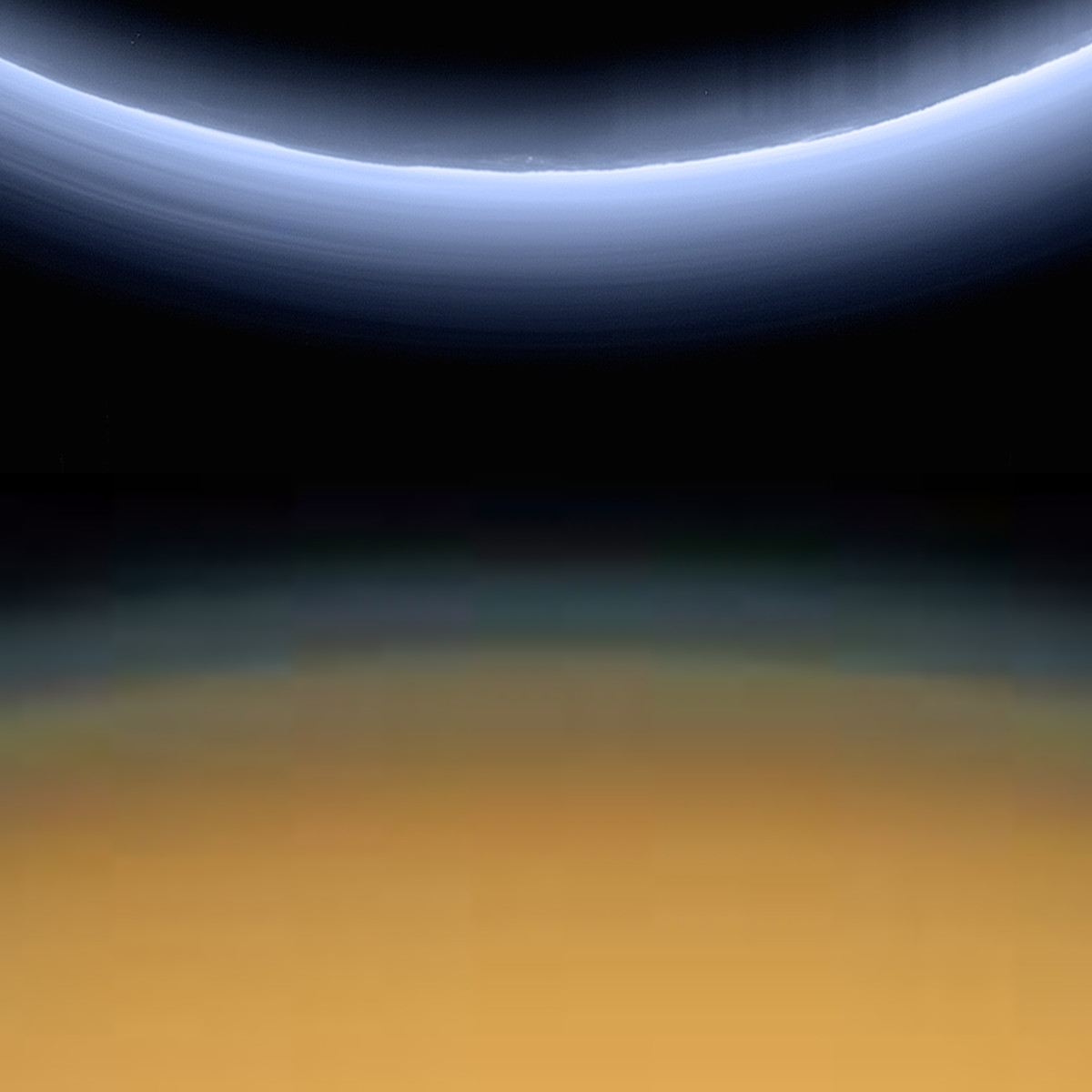
The image above reveals a portion of Titan in the lower part of the view as well as a portion of Pluto in the upper part of the view. The original view of Titan was obtained on January 30, 2012 from the Cassini spacecraft. The original view of Pluto was obtained on July 14, 2015 from the New Horizons spacecraft. The views of Titan and Pluto are at scale. Each side of the image represents about 1000 km. One can notice, in particular, a multitude of layers in Pluto's atmosphere and a detached haze layer in Titan's atmosphere. A parallel can be drawn between the haze on Titan and the haze on Pluto. Credit for the original view of Titan: NASA/JPL-Caltech/Space Science Institute. Credit for the original view of Pluto: NASA/Johns Hopkins University Applied Physics Laboratory/Southwest Research Institute. Credit for the montage: Marc Lafferre, 2020.
January 17, 2020 : Some Researchers May Have Solved The Mystery Of The Reversed Spin Of The Huygens Probe During Its Atmospheric Descent
About 15 years ago, on January 14, 2005, the Huygens probe released from the Cassini orbiter performed an atmospheric descent and landed on the surface of Saturn's largest moon Titan for the first time in history. The Huygens probe which was proposed by ESA and ASI had separated from the Cassini spacecraft proposed by NASA at the end of December 2004. During the atmospheric plunge of January 14, 2005, the Huygens probe started to spin the wrong way and engineers and researchers had not anticipated that configuration. That mystery may have been solved thanks to recent tests or simulations. In fact, during the atmospheric journey, some instruments of the probe may have generated an unexpected torque opposite to that engendered by the 36 angled vanes of the Huygens probe. The vanes played a key role since they were used to control the rotation of the probe during its descent inside the deep and thick atmosphere of the giant moon. The atmosphere of Titan like the atmosphere of Venus or like the atmosphere of Mars makes any parachute useful for any probe that dives to the surface.
Researchers have been in a position to determine that two devices of the Huygens probe, the Separation Subsystem (SEPS) and the Radar Altimeter (RA) antennae, actually engendered an unexpected torque opposite to that generated by the multiple vanes. That phenomenon was strengthened due to the alteration of the gas flow around the atmospheric probe by the vanes which led to a rise in the amplitude of the « negative torque ». Let's point out that the negative torque corresponds to the effect that made the Huygens module flip its direction of rotation. The unexpected effect turned out to exceed the influence of the vanes. It is crucial for engineers to clearly understand the mechanisms that led to the unexpected configuration in the prospect of the development of future probes sent to extraterrestrial atmospheres like the atmosphere of Venus, Mars, Titan or the four Gas Giants. The behavior of any atmospheric probe can engender scientific failures. That's why engineers and scientists must be in a position to anticipate any scenario during the complex phase of the atmospheric descent.
The image above represents a mosaic of aerial views of Titan's landscape obtained from the DISR of the Huygens probe during its atmospheric plunge on January 14, 2005. The views were acquired at an altitude of approximately 8 km and the resolution of the landscape features is about 20 meters per pixel. One can clearly notice a sharp contrast between bright hills composed of a network of dark channels and a dark plain which seems quite uniform. The Cassini-Huygens mission represented the outcome of a collaboration between ESA, NASA and ASI. Image credit: ESA/NASA/JPL/University of Arizona.
January 7, 2020 : A New Research Work Involving Takahiro Iino Reveals That ALMA Has Measured The 14N/15N Isotopic Ratio In CH3CN Of The Opaque Atmosphere Of Titan
A new research work proposed on January 7, 2020 by a team of researchers composed of Takahiro Iino, Hideo Sagawa and Takashi Tsukagoshi and presented in Arxiv reveals the measurement of the 14N/15N isotopic ratio in CH3CN in the atmosphere of Saturn's largest moon Titan via ALMA. The planetologists were in a position to detect submillimeter rotational transitions of CH3C15N found at the 338 GHz band in the spectra of Titan's opaque atmosphere thanks to the analysis of archival data collected by the Atacama Large Millimeter/submillimeter Array (ALMA). A comparison between those observations and the simultaneously observed CH3CN lines at the 349 GHz band, which allow us to study the area from the altitude of 160 km to the altitude of about 400 km, allowed the researchers to deduce the value of the ratio 14N/15N in CH3CN at about 125. The level of accuracy remains limited but it allows the scientists to advance that the value of 14N/15N for CH3CN is higher than the values that have been previously determined and theoretically predicted for HCN and HC3N. The difference may be related to the different N2 dissociation factors whose impact depends on the altitude as proposed by a recent photochemical model.
The isotopic ratio between 14N and 15N can vary in the various nitriles present in Titan's atmosphere. The differences are closely related to the production processes of the molecules. The dissociation processes of N2 can be generated via the action of ultraviolet light from the Sun, via the action of magnetospheric electrons or via the action of galactic cosmic rays. Regarding the nitrile CH3CN, a photochemical model predicted a value of 120-130 in the lower part of the stratosphere for the isotopic ratio 14N/15N. The expected value is much higher than that for the nitriles HCN and HC3N which is, approximately, between 67 and 94. The value of 125 for the ratio 14N/15N in the molecule CH3CN which was measured by ALMA appears clearly higher than the value measured and predicted for the ratio 14N/15N in the molecules HCN and HC3N. The dissociation factors which depend on the altitude must be considered. Researchers are particularly interested in the chemistry of Titan's complex atmosphere which represents, to a certain extent, a soup of various molecules, elements or ions and which may resemble the atmosphere of the Early Earth.
|
The image in the upper part of the table reveals a raw image of Titan's disk obtained from the Cassini spacecraft on December 14, 2009. The image whose file name is N00148433.jpg was acquired using the CL1 filter and the MT3 filter. The view had not been validated or calibrated. A validated or calibrated view was going to be archived with the Planetary Data System proposed by NASA. The image in the lower part of the table represents a colorized version of the raw image. Credit for the raw image: NASA/JPL-Caltech/Space Science Institute. Credit for the colorization of the raw image: Marc Lafferre, 2020. |
Titan News 2019
Titan News 2018
Titan News 2017
Titan News 2016
Titan News 2015
Titan News 2014
Titan News 2013
Titan News 2012
Titan
News 2011
Titan
News 2010
Titan
News 2009
Titan News 2008
Titan
News 2007
Titan
News 2006
Titan News
2004, 2005
